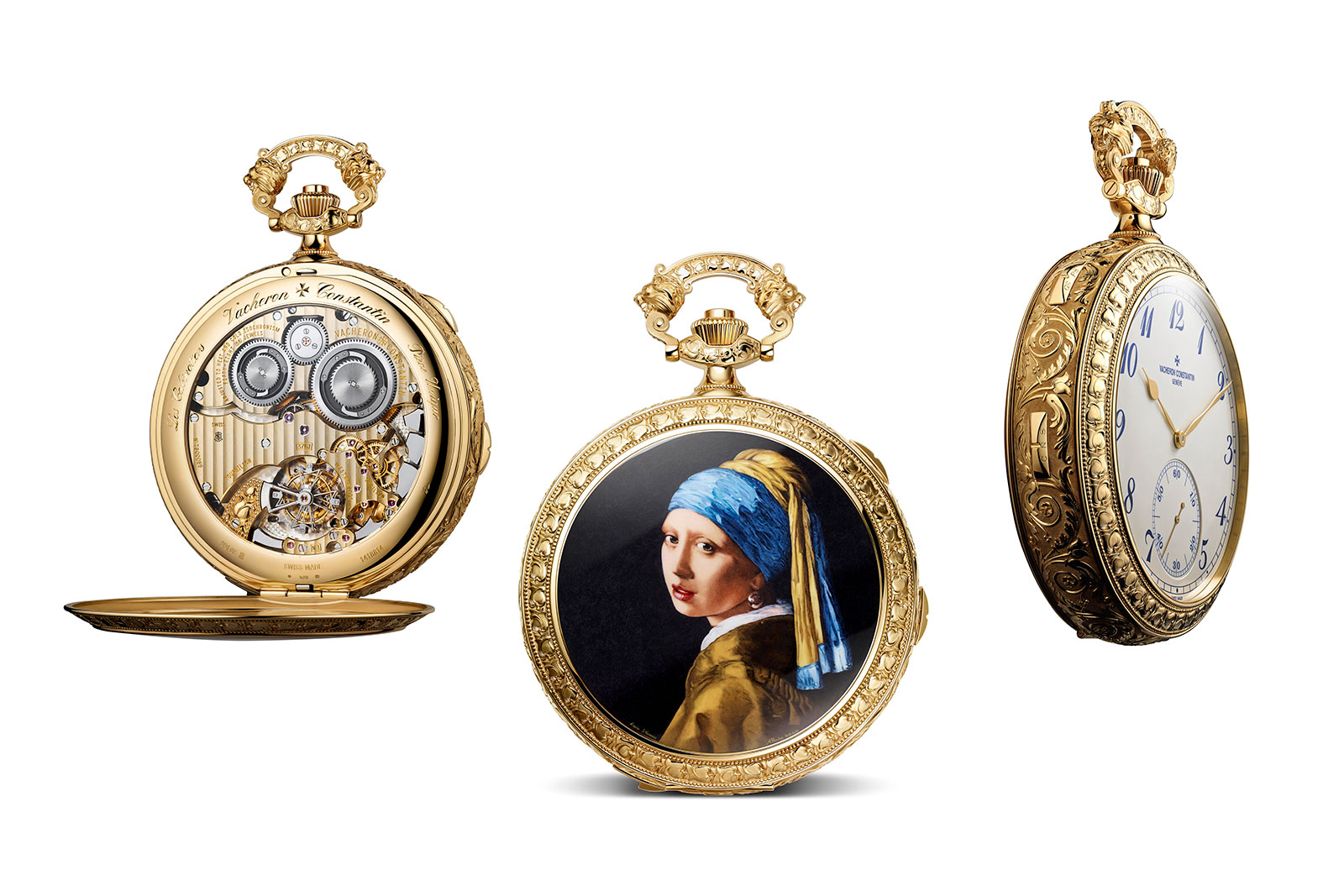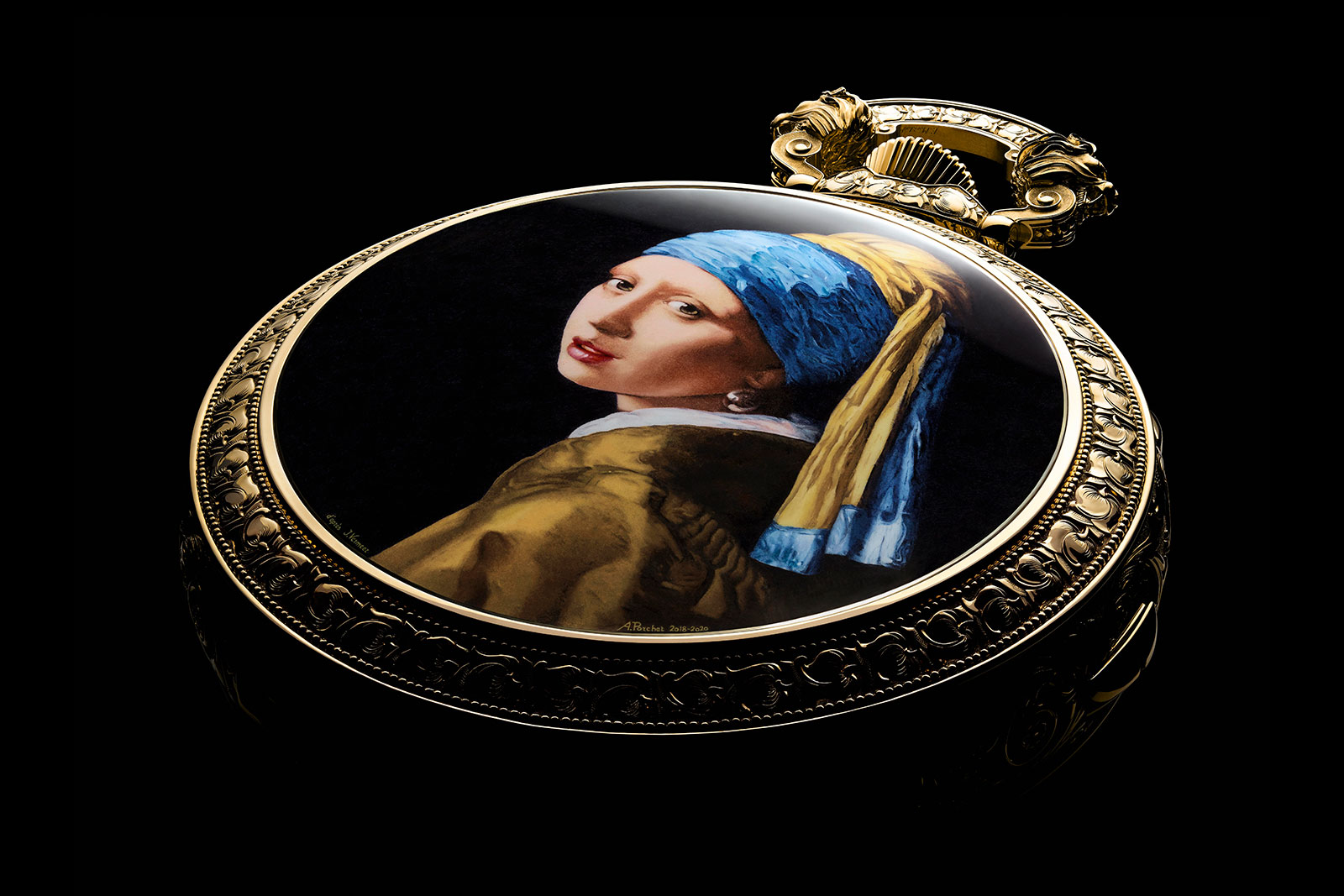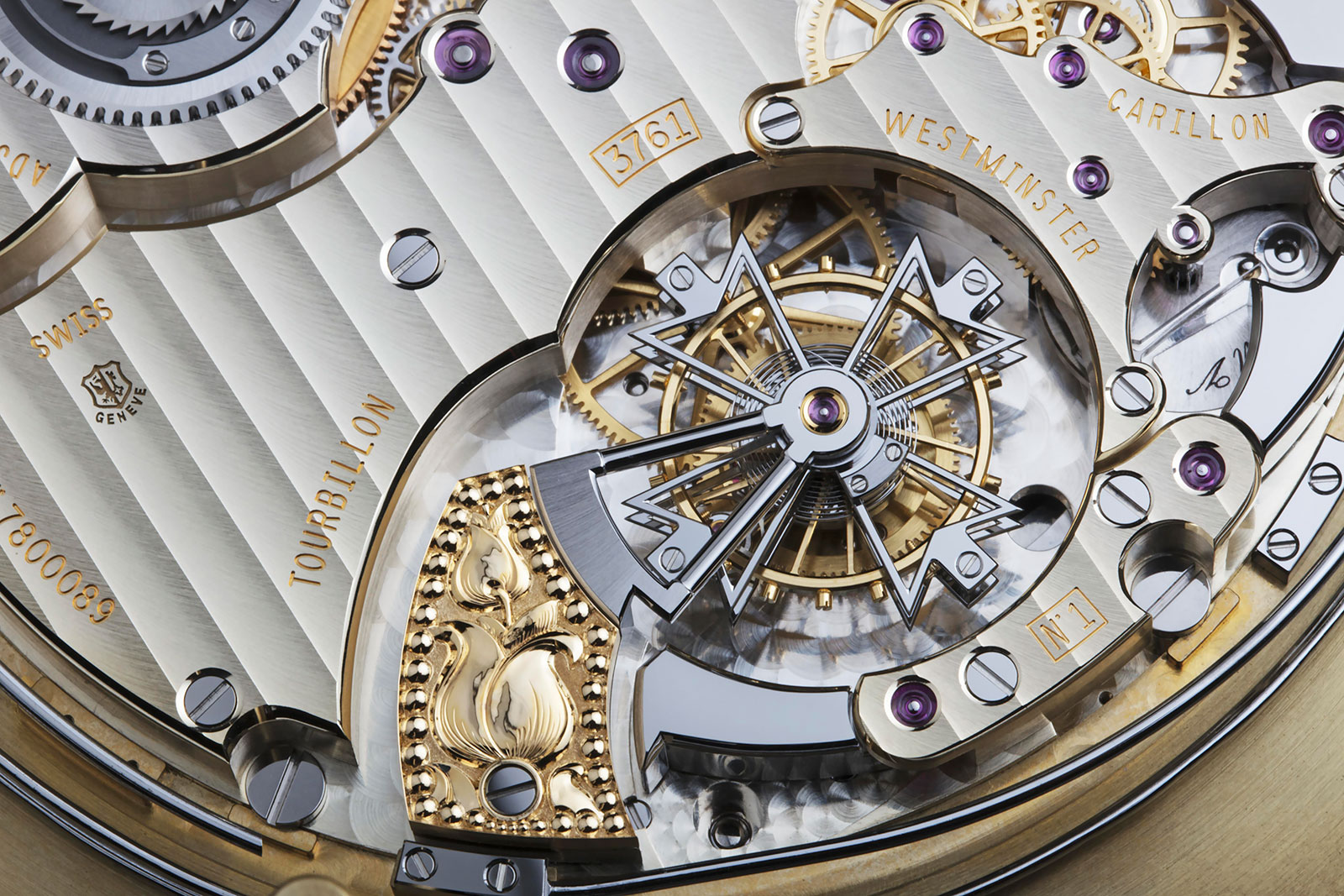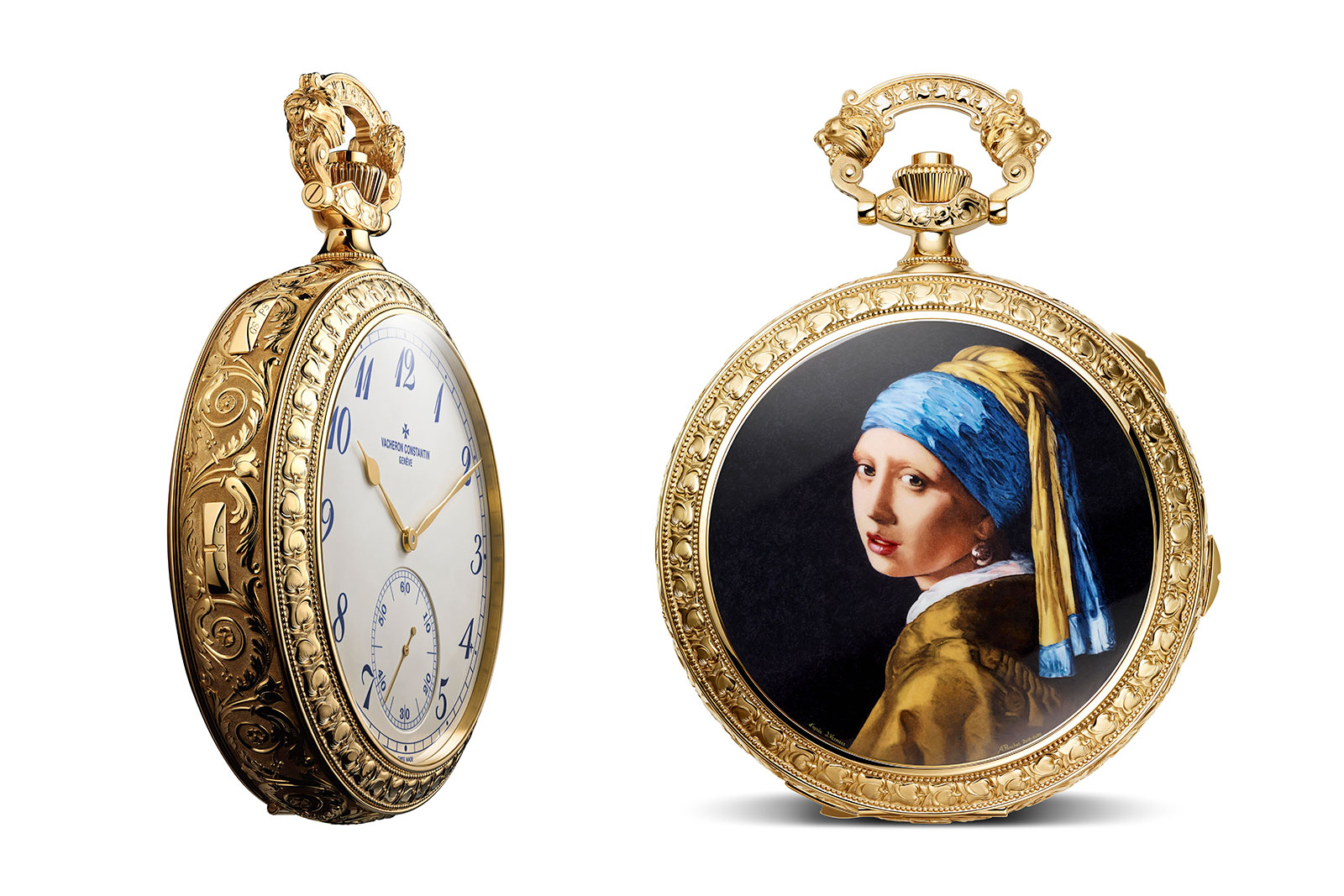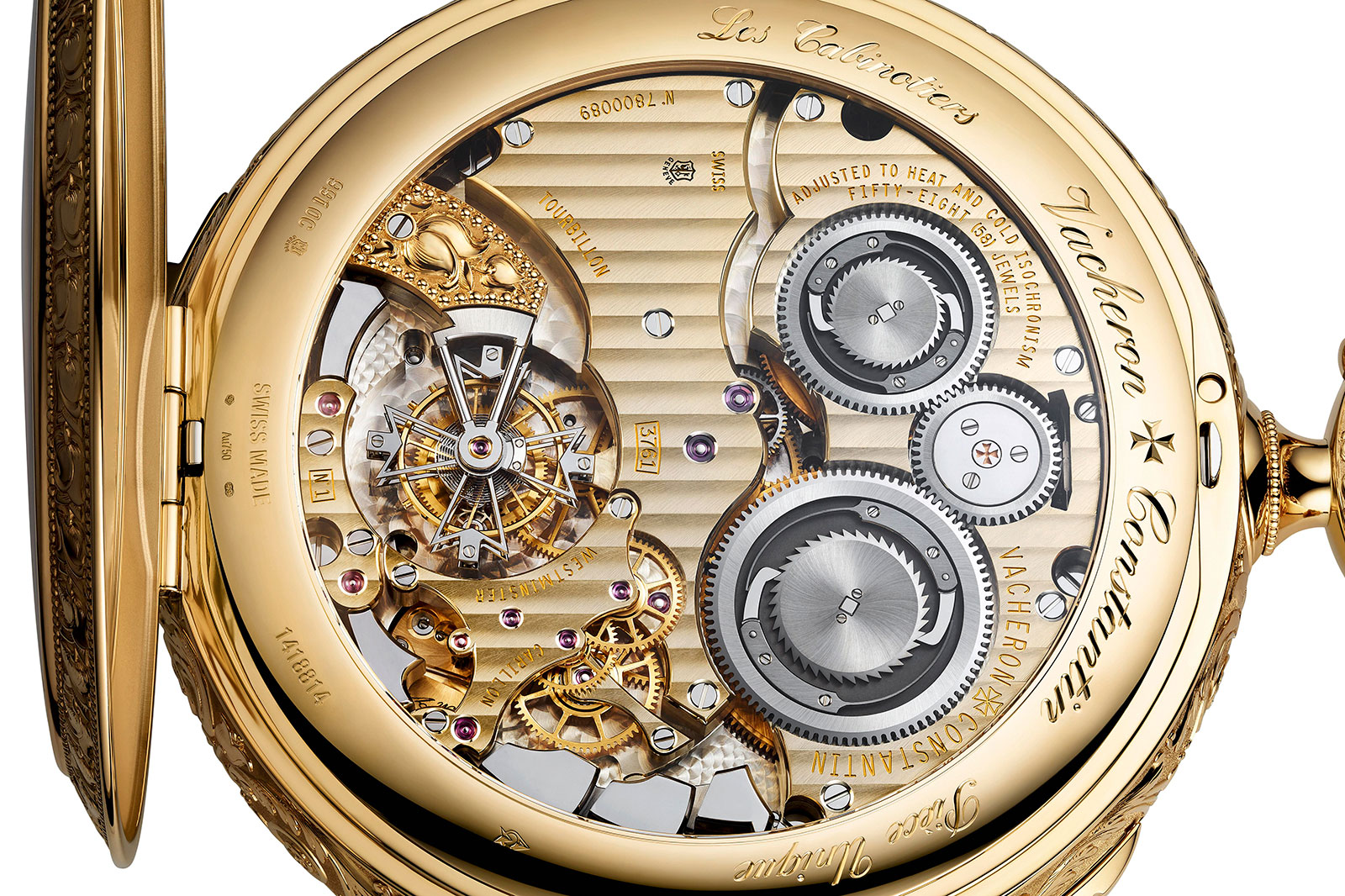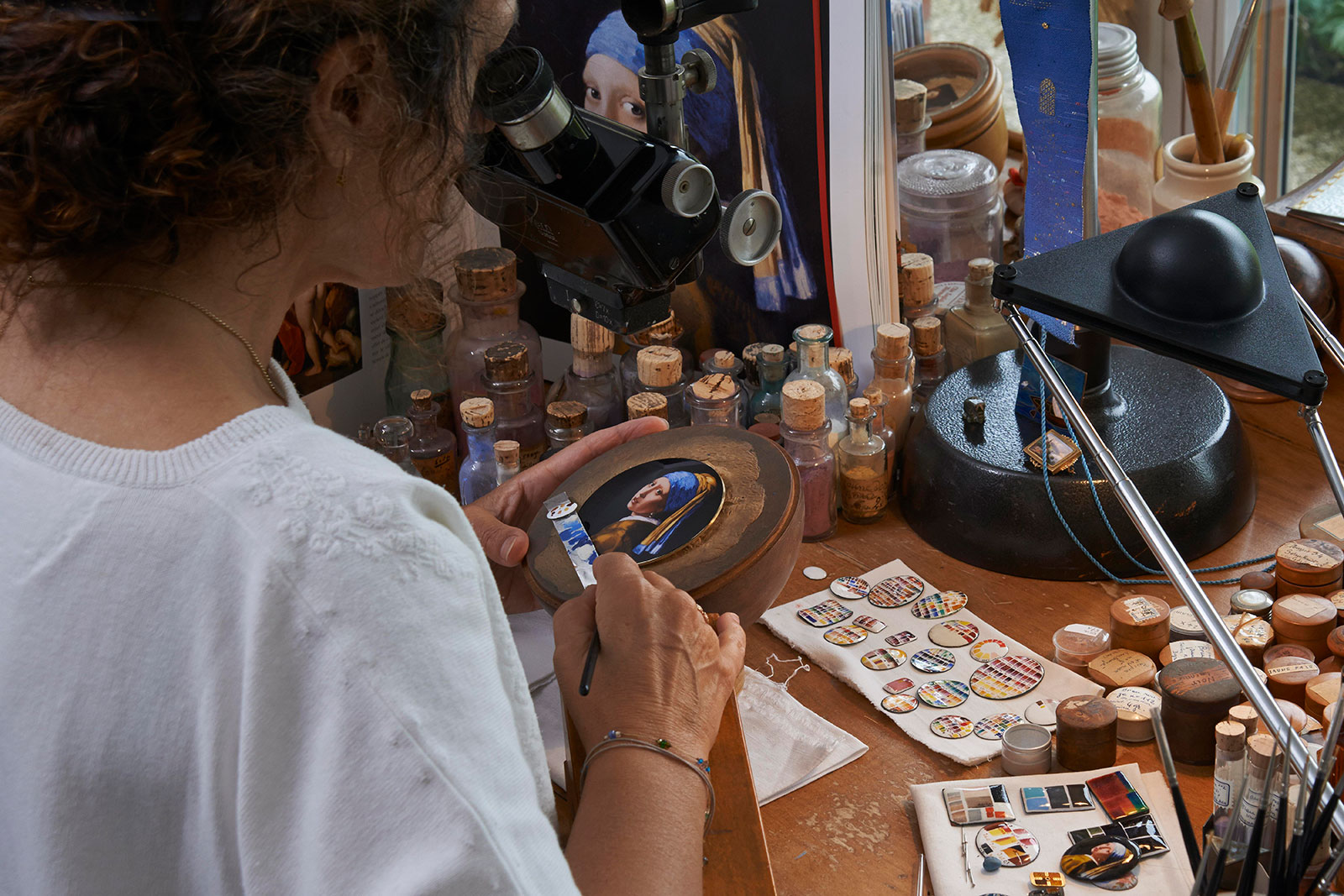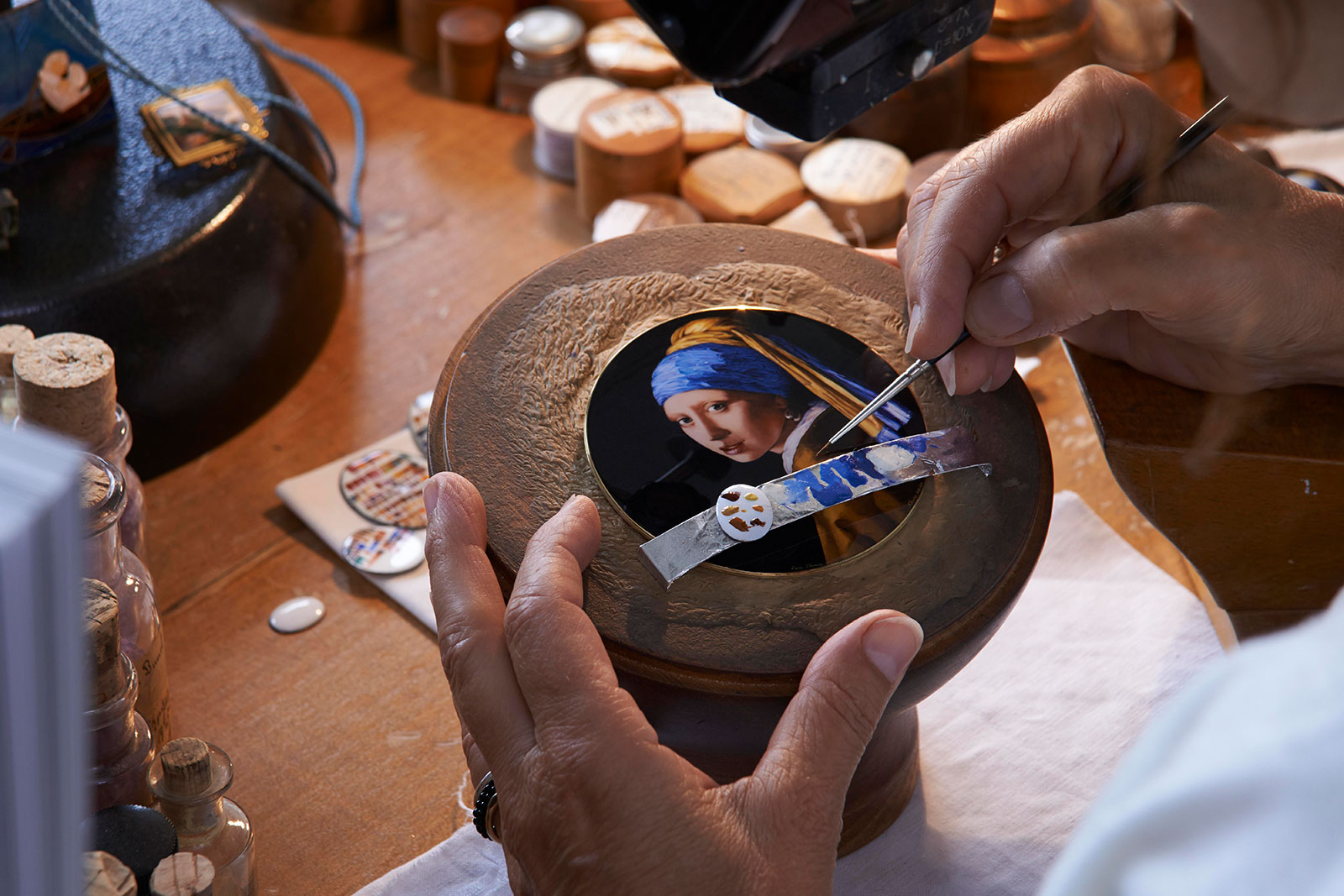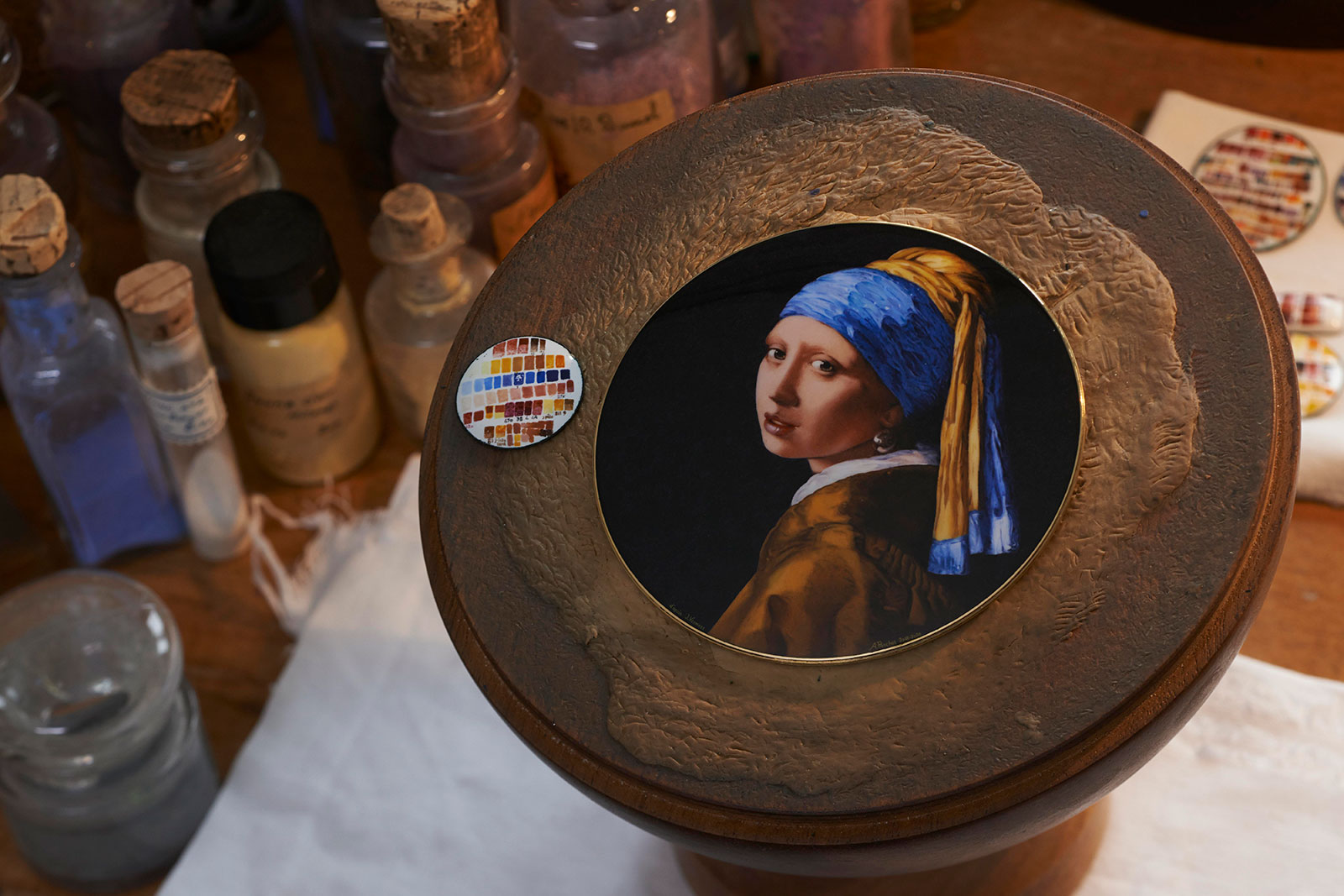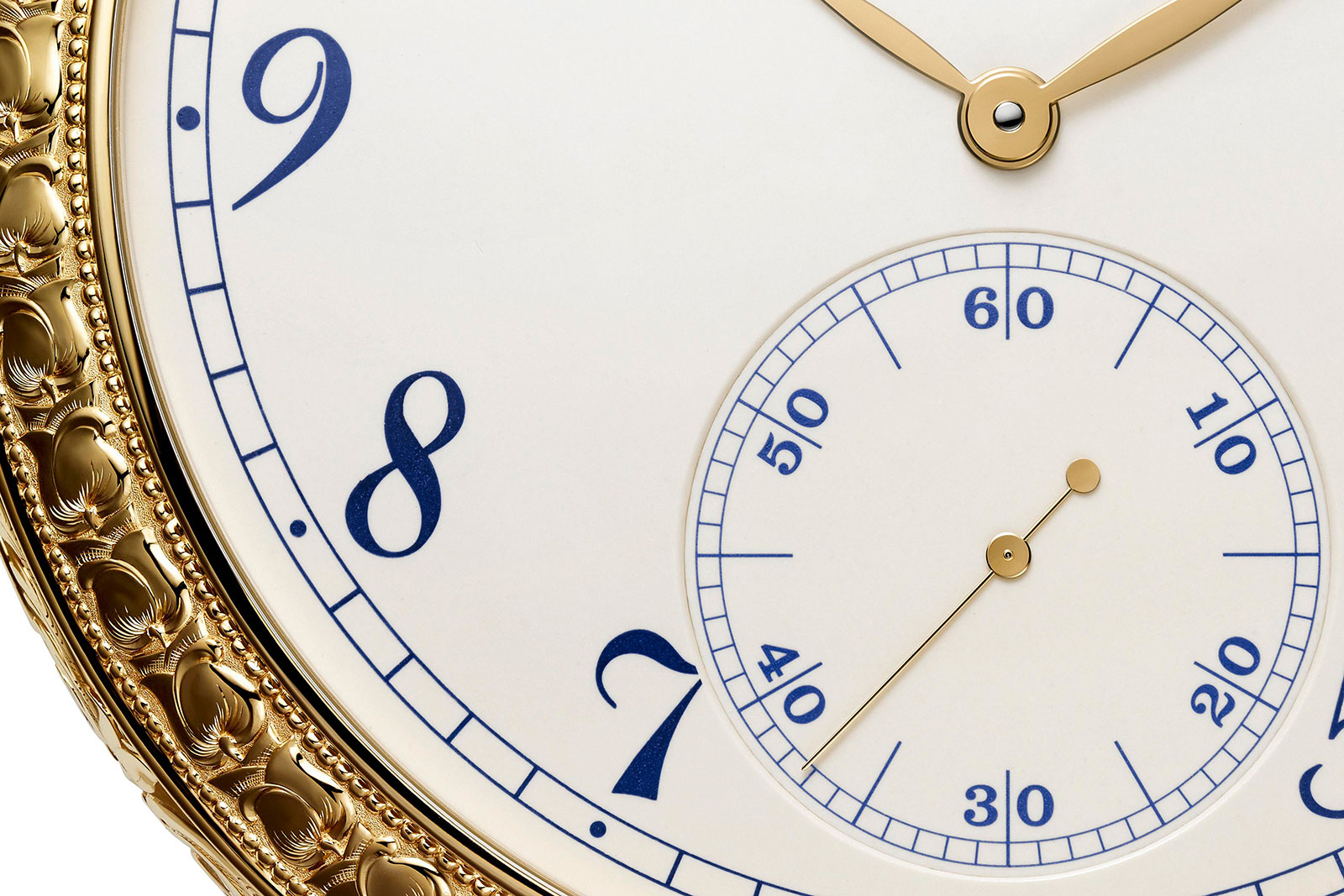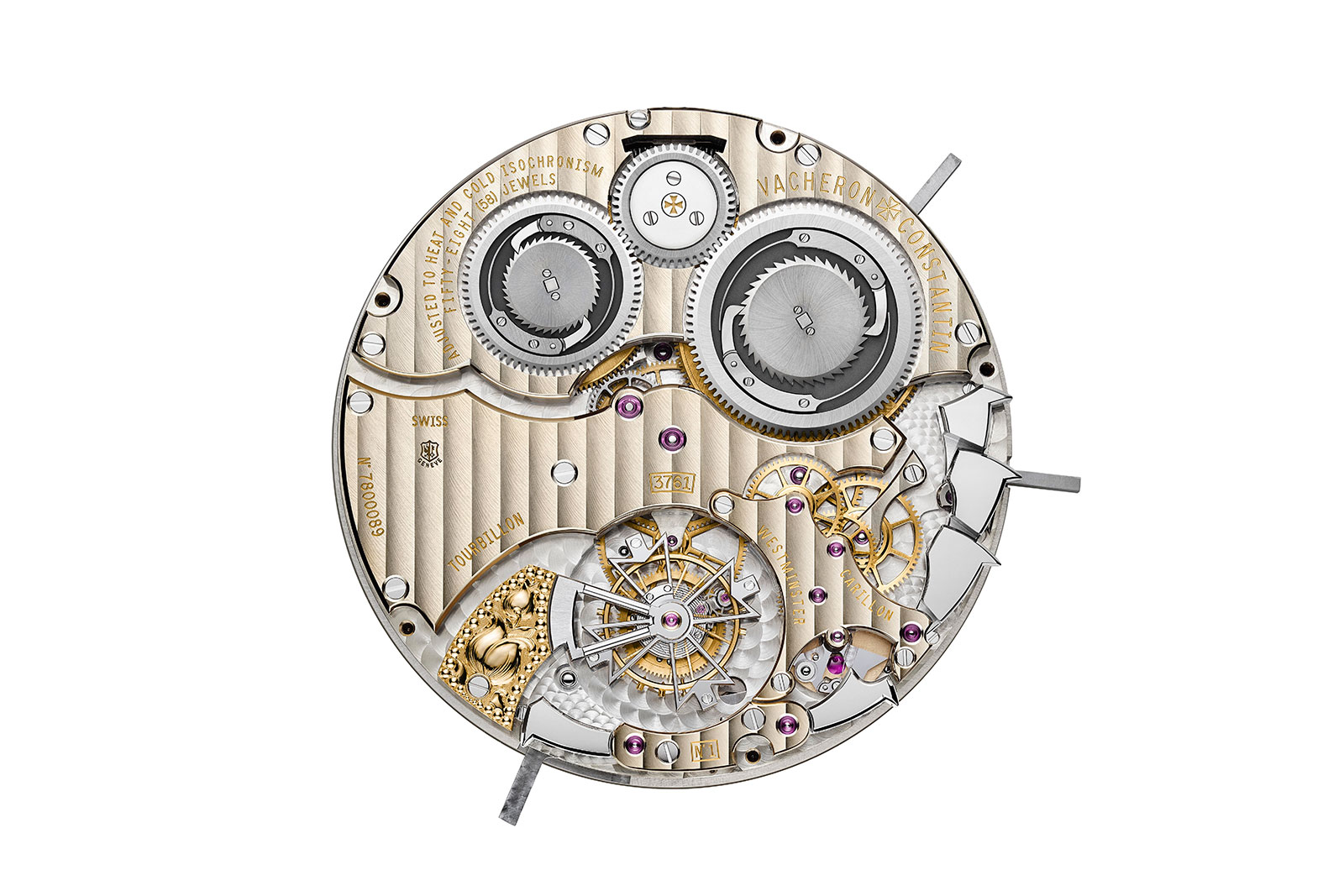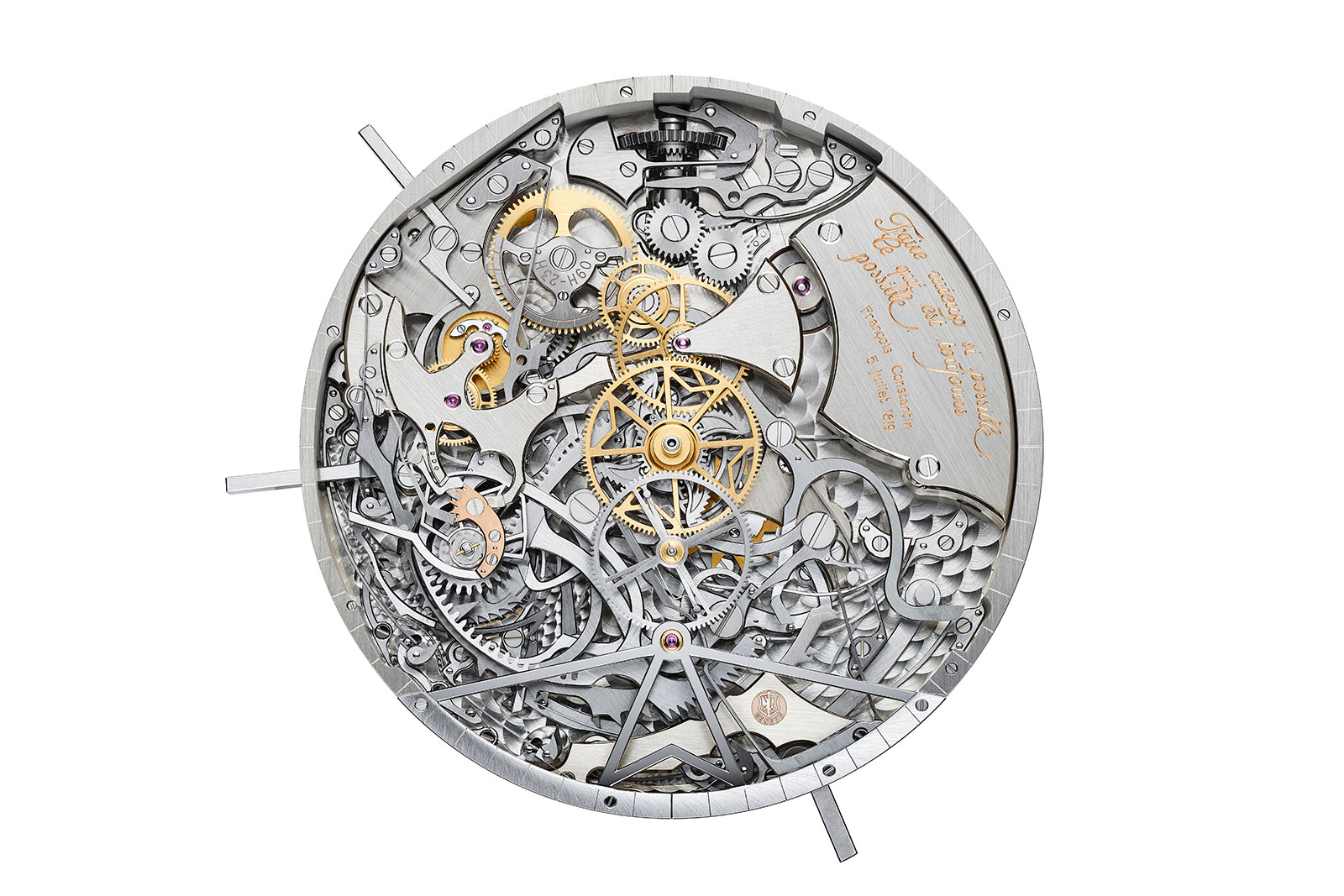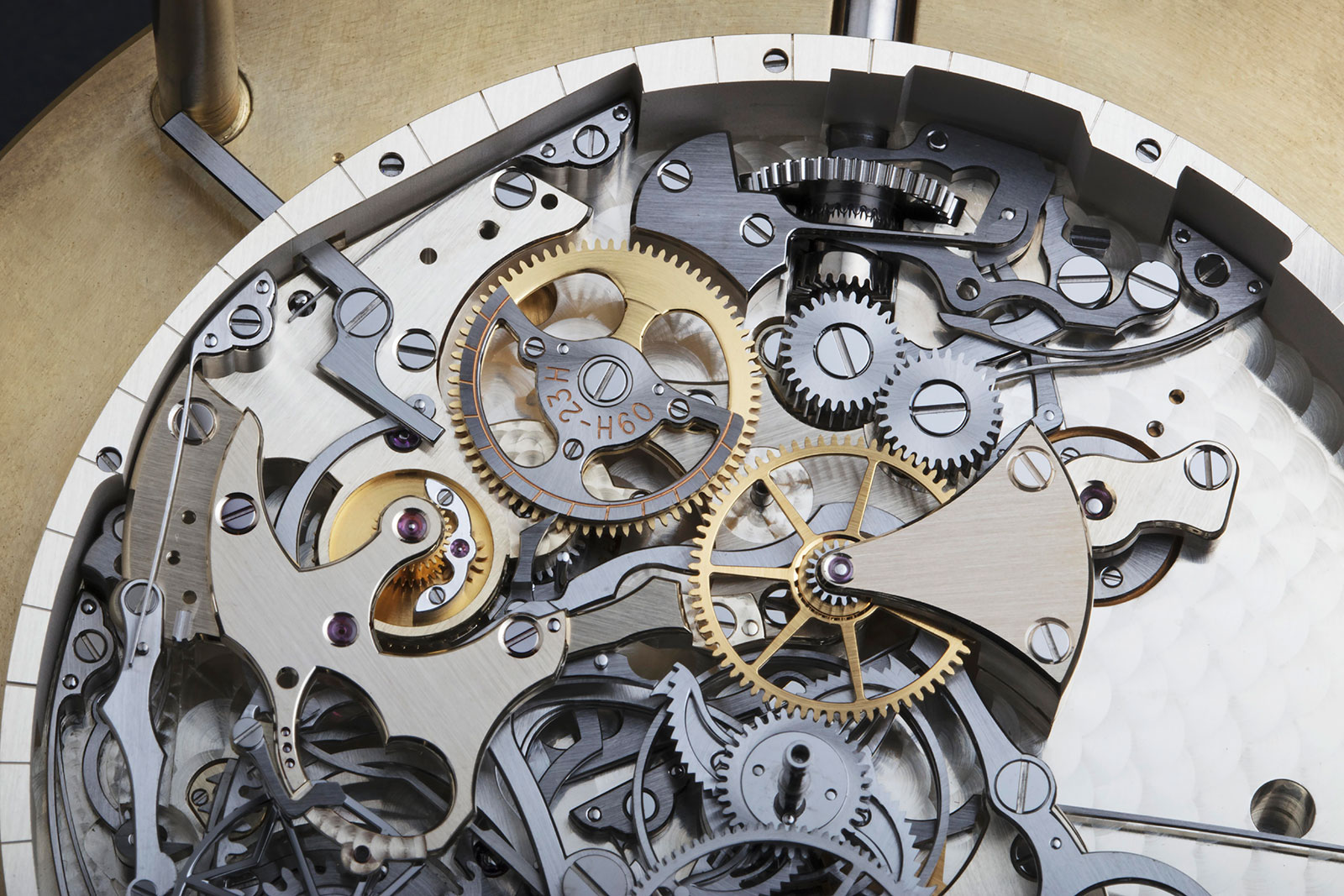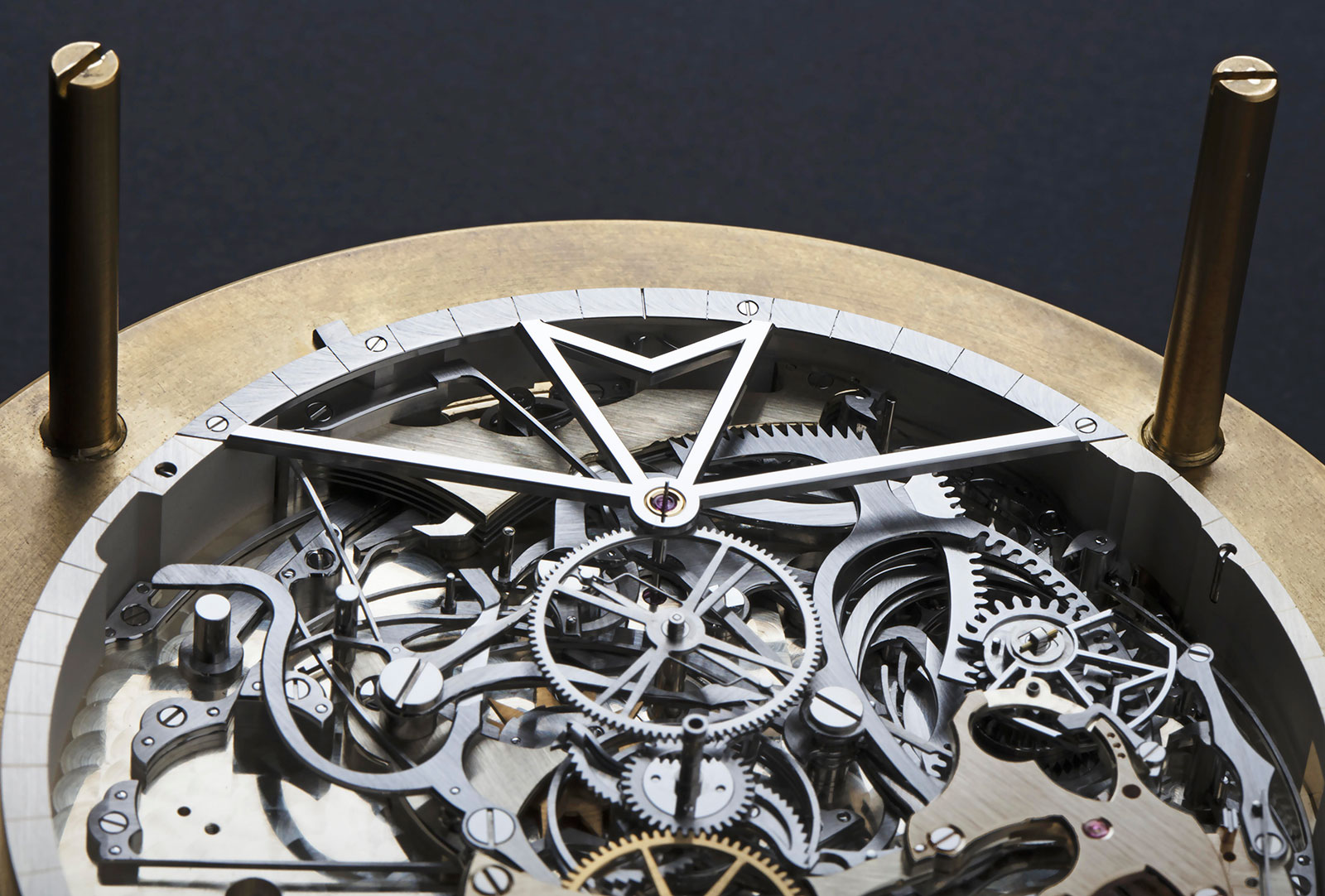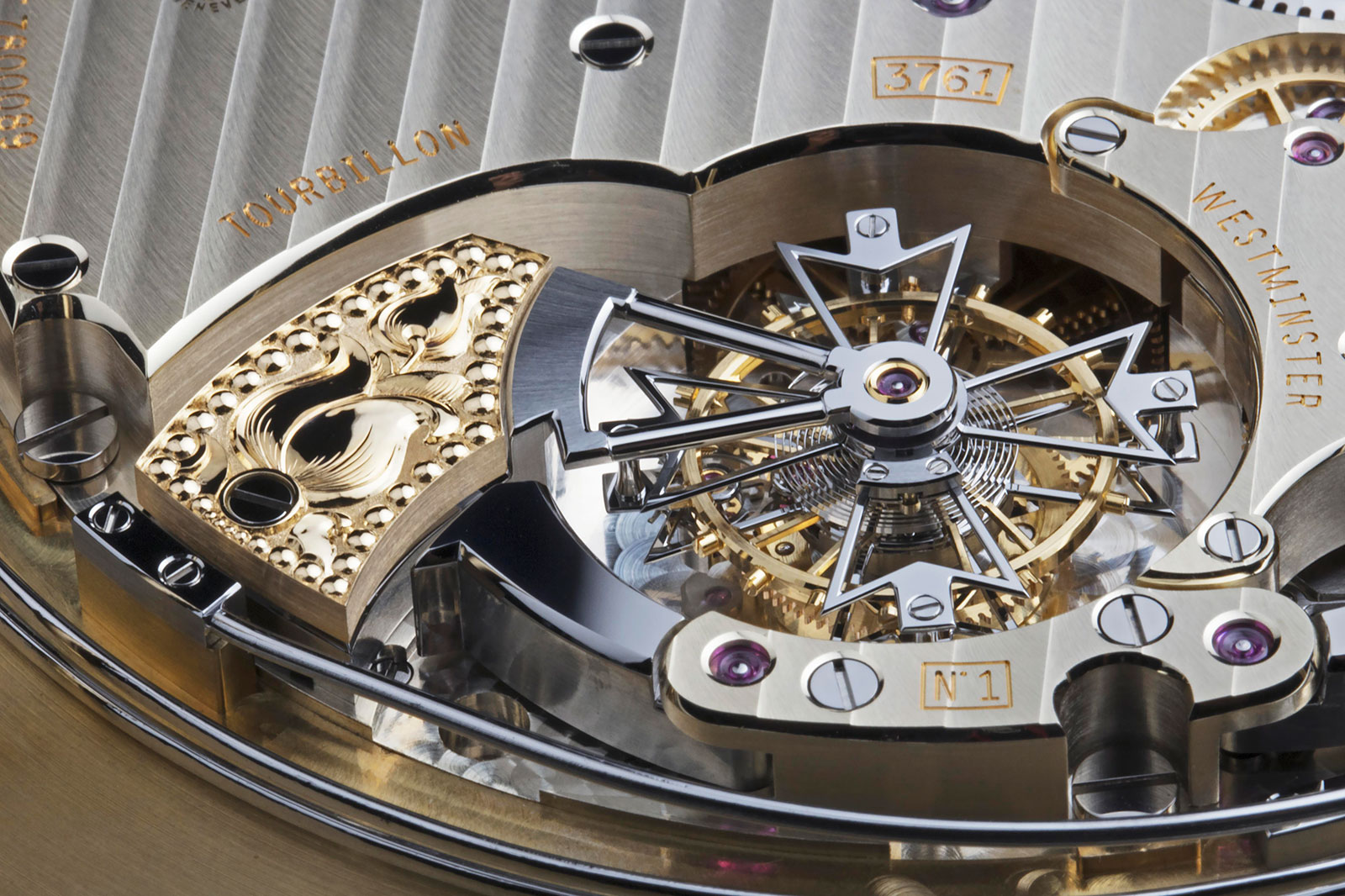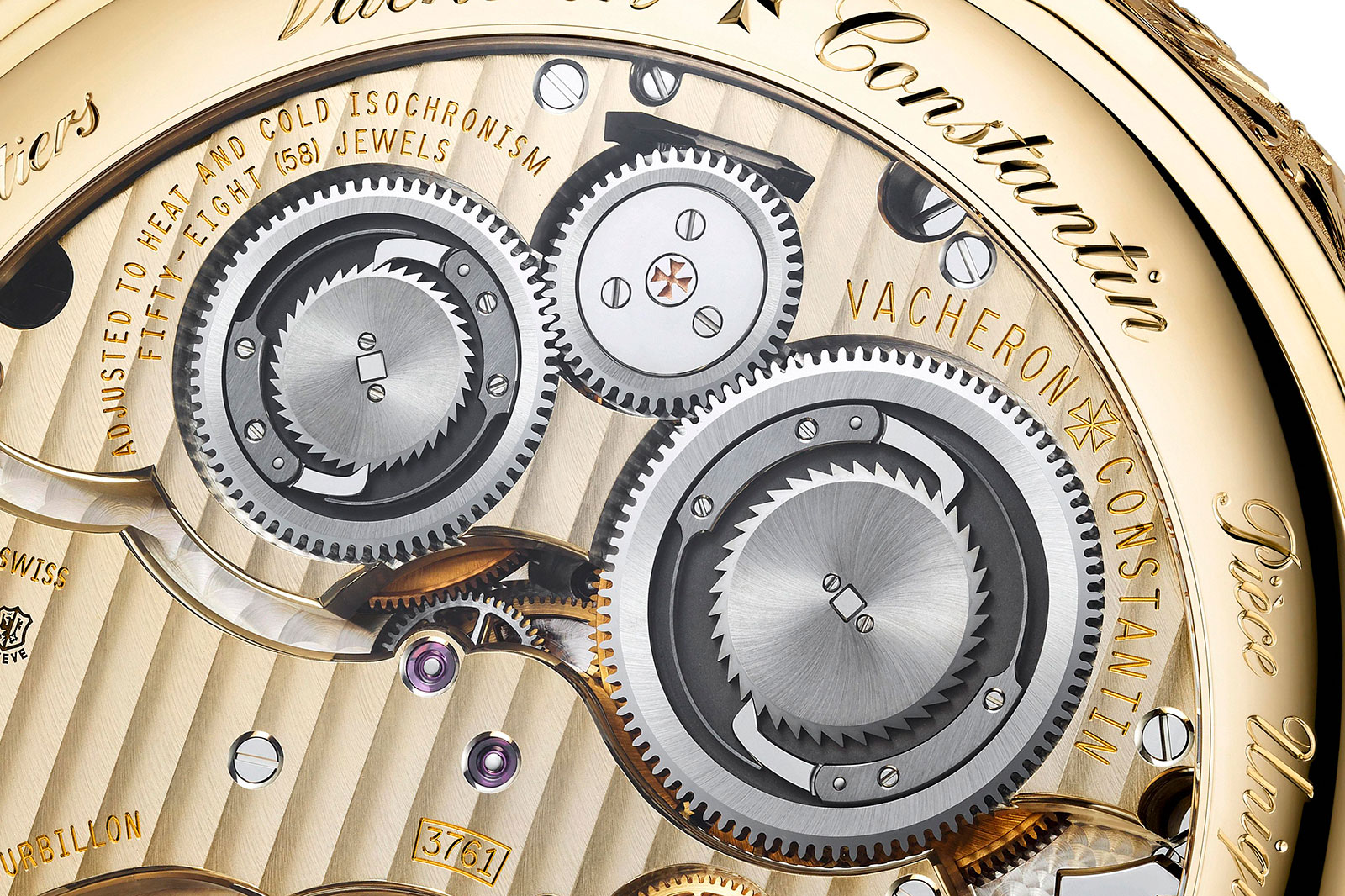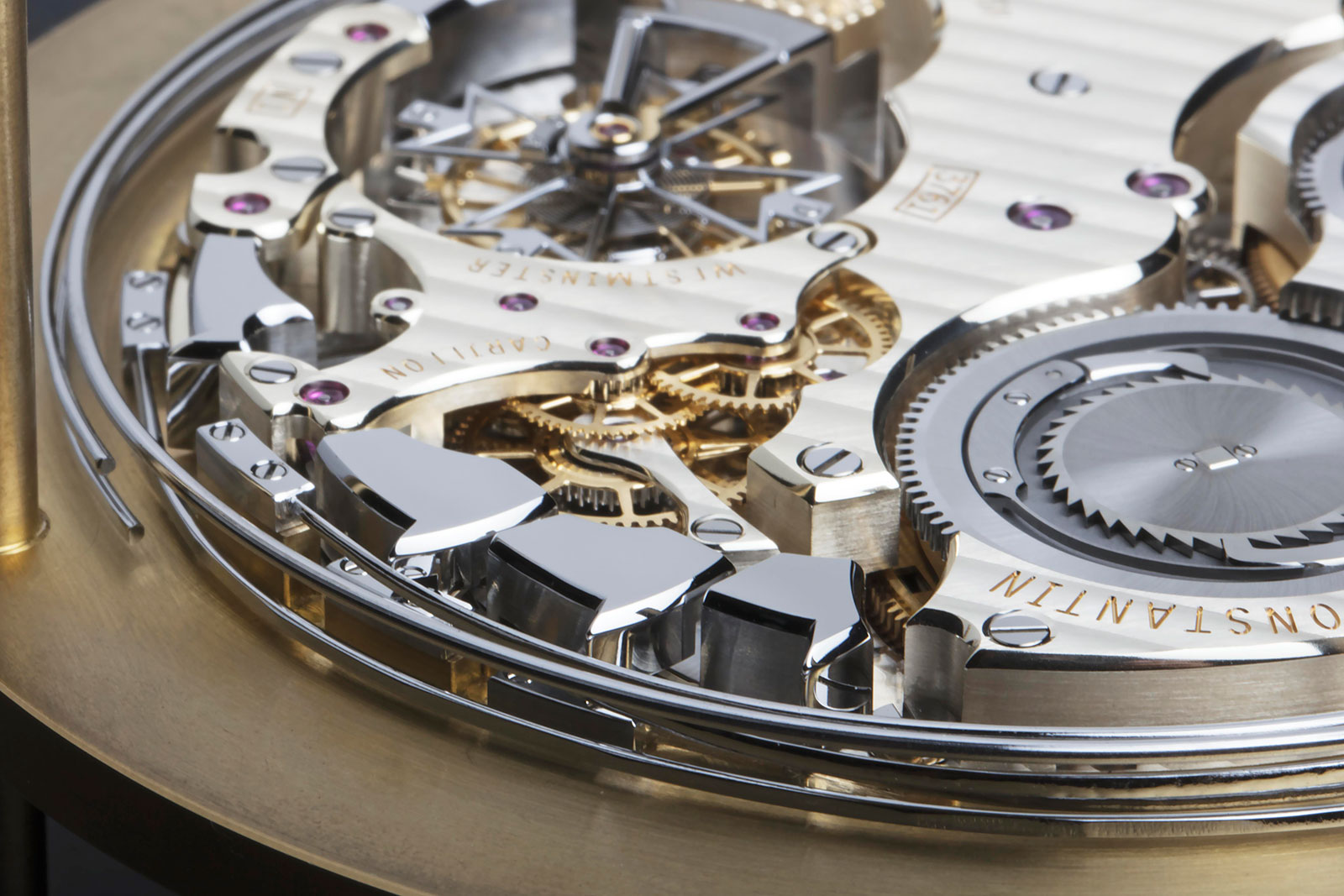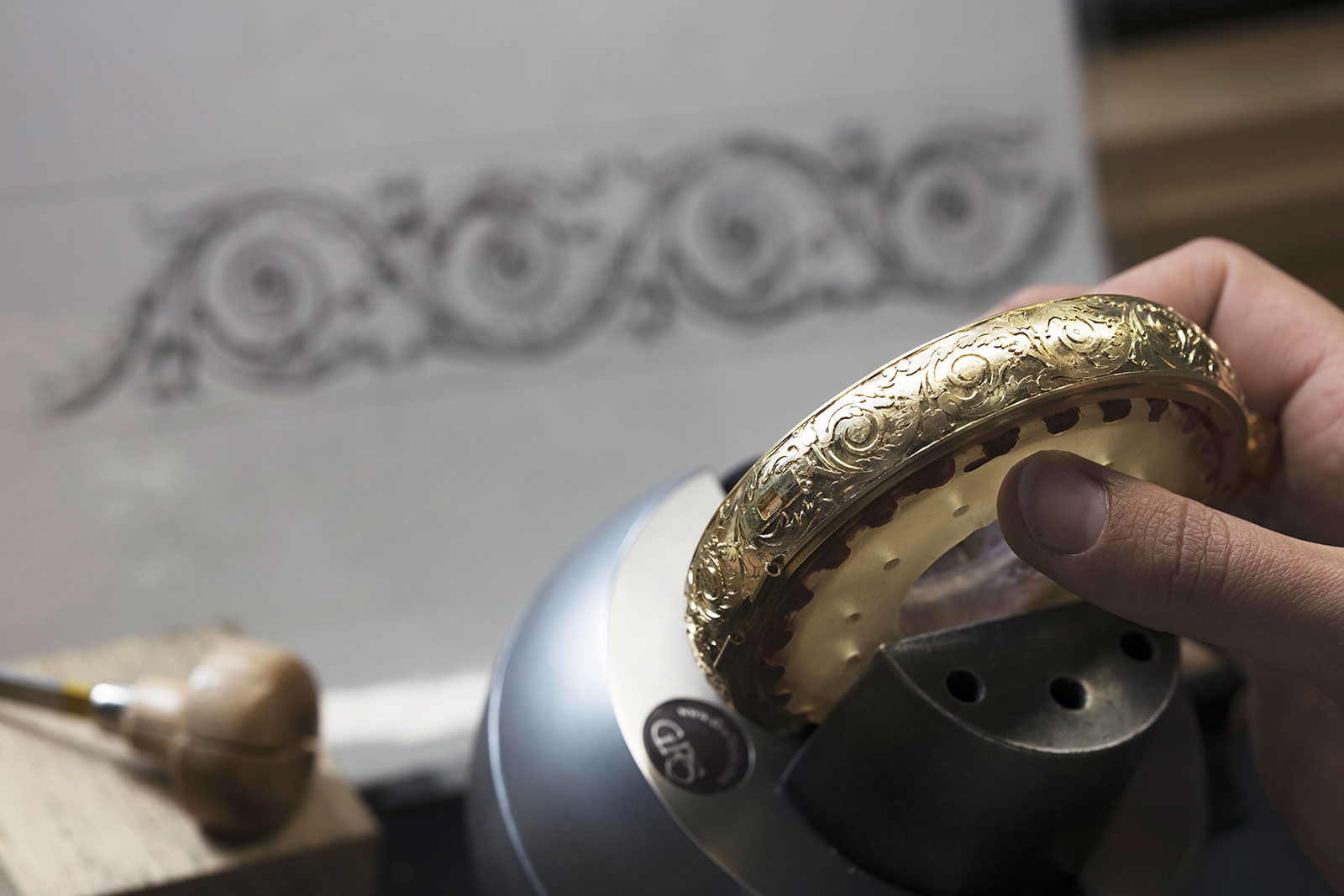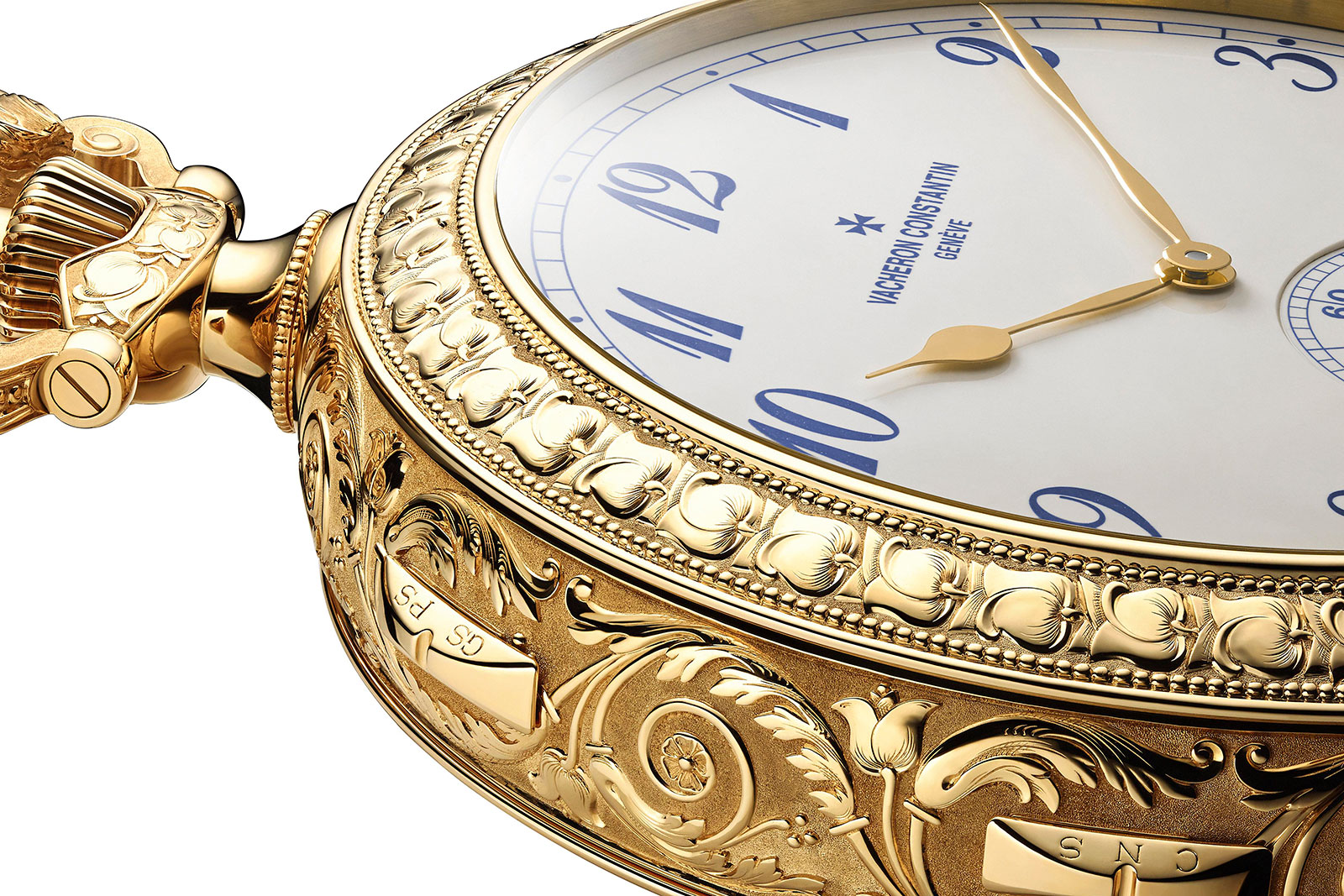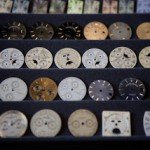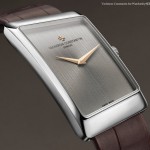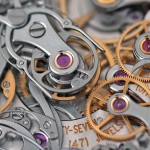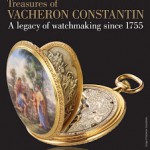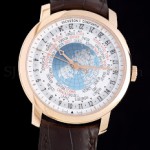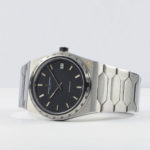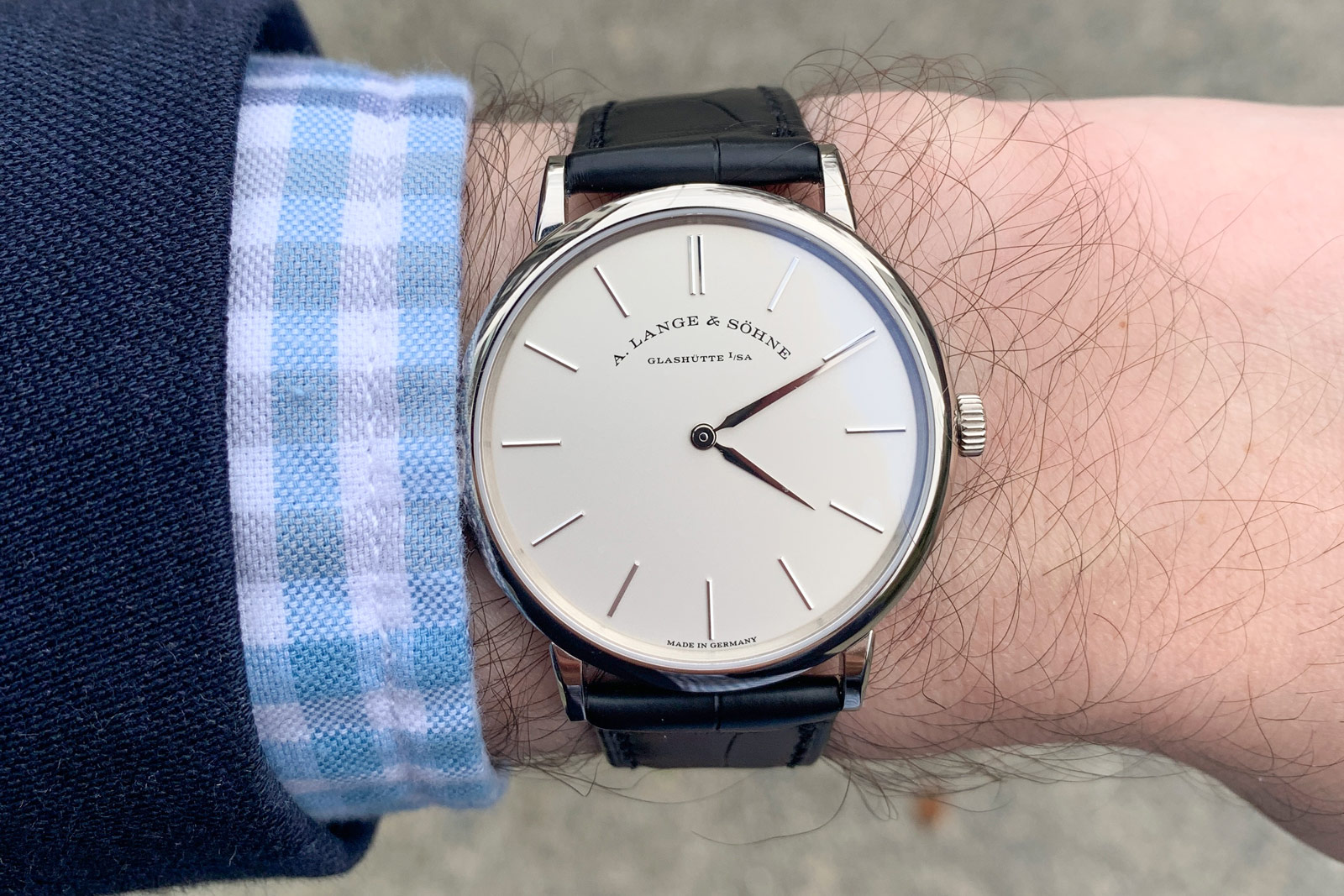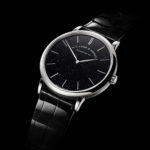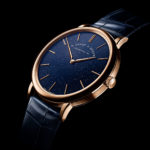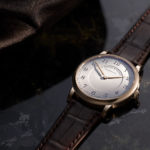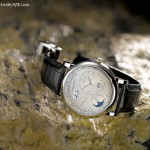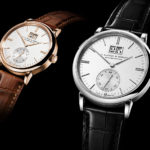A. Lange & Söhne introduced the Saxonia Thin 37 at SIHH 2016 as the entry-level model in its collection. But “entry level” is relative at Lange, a brand that famously applies the same rigorous standards of production and finishing to all its watches, from the Saxonia Thin to the Lange 1 Tourbillon Perpetual Calendar that retails for more than US$300,000.
For the purpose of this review, I will put this reputation to the test by examining each element of the watch in detail, and share my impressions of the ownership experience.
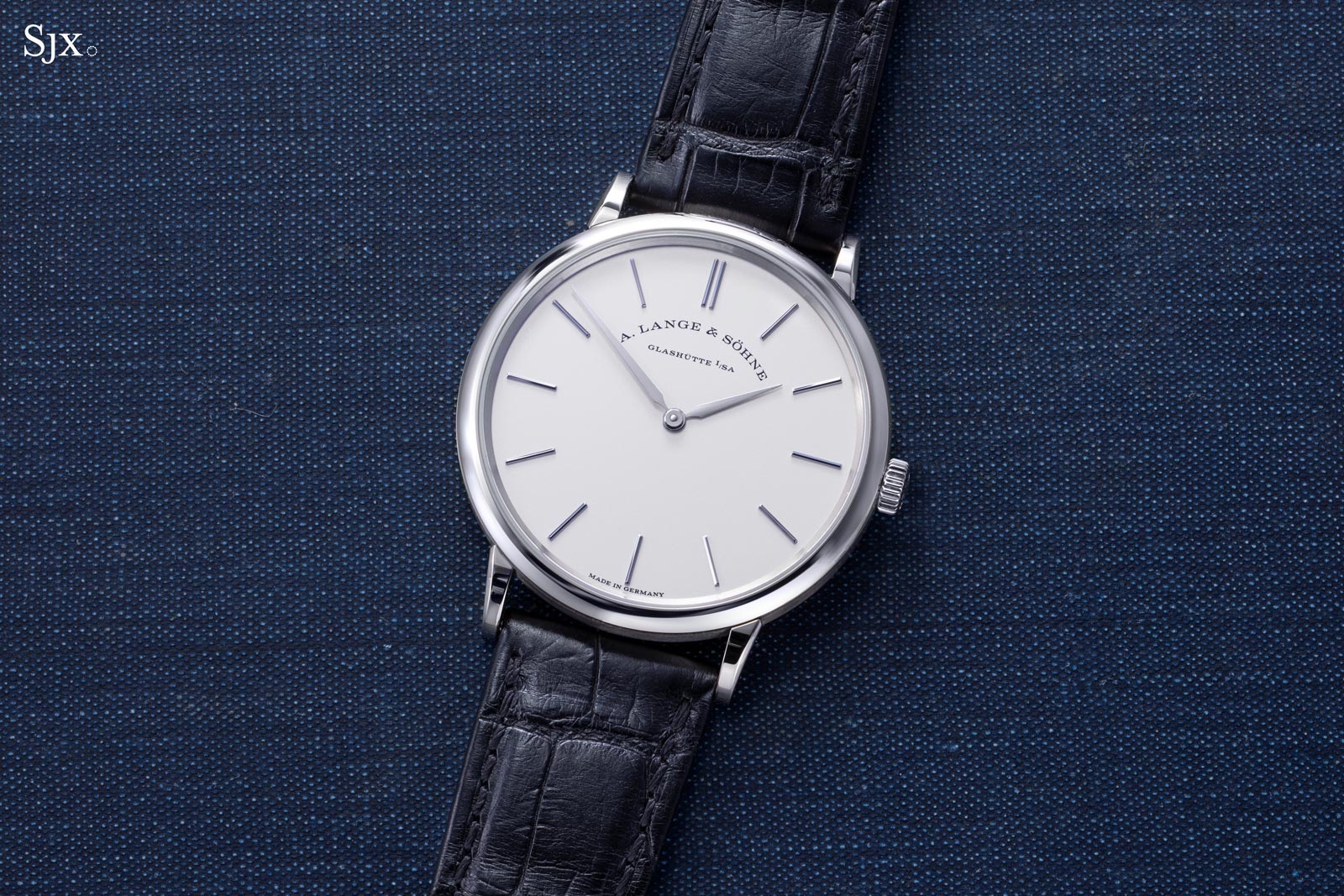
Glashüttenomics
Though owned by Swiss luxury conglomerate Richemont – which owns over two dozen brands including Cartier, IWC, and Panerai – Lange remains a boutique outfit with an annual output of about 4,500 watches, and a maximum production capacity of about 5,500 watches. This is a fraction of competitors like Audemars Piguet at about 45,000 watches per year, and Patek Philippe, where the figure is over 60,000.
While production volume is small, Lange is the largest employer in Glashütte, a small town with a population of about 8,000. Lange employs about 600 people at its Glashütte campus, though some commute in from the surrounding region, including the city of Dresden.
This headcount is primarily devoted to watchmaking, since Lange relocated its marketing department to Berlin in 2017. For comparison, Glashütte Original has a similar number of employees in Glashütte, while producing about 13,000 watches per year, or about three times what Lange does, albeit at a far more affordable price on average.

The Lange manufacture in Glashütte. The original building is on the left, and the new building that was completed in 2015 is on the right. Both are connected by a skybridge over Altenberger Strasse. Photo – the author
I find this data interesting because it illustrates the labour-intensive nature of watchmaking in Glashütte. The town is in former East Germany and a short drive from Poland and the Czech Republic, explaining why its labour costs are lower than in Switzerland.
Given that Lange’s margins are estimated to be in line with industry norms, this labour cost advantage means that at a given price point, Lange is able to allocate more hours to hand finishing than its Swiss rivals, something that is evident in the final product.

Another view of the manufacture from my visit in 2016. Photo – the author
Since more human hours are spent with each piece, Lange only produces about seven watches per watchmaker each year. The term “watchmaker” is subjective, so for the sake of comparability I’m using a relatively broad definition and counting all 650 staff in its manufacture, which is made up of several buildings on each side of Altenberger Strasse, the main thoroughfare of Glashütte.
Using the same benchmark, the equivalent ratio at establishment Swiss haute horlogerie brands is 20:1, or 20 watches per watchmaker per year. Lange’s 7:1 ratio puts the brand in good company, placing it with small independent watchmakers like Laurent Ferrier and De Bethune. At the very top of the price spectrum, there are brands like Roger Smith and Greubel Forsey where the ratio is around 1:1.
In contrast, Patek Philippe produces more than 40 watches per watchmaker per year (44:1), assuming a similar headcount breakdown as Lange, with about 85% of Patek’s 1,600 total employees based at the manufacture. Counting only mechanical watches (assuming Patek produces about 12,000 quartz watches per year), this reduces the ratio to around 35:1.
As it relates to time spent on movement finishing, the actual disparity is probably even wider given that Lange’s watchmaking headcount is concentrated on movements, and not spread across other areas like case and dial production, which it outsources to a small circle of suppliers. Lange’s decision to focus exclusively on movement production and leave the rest to specialists is something I appreciate as a collector who’s focused on movement quality first and foremost.
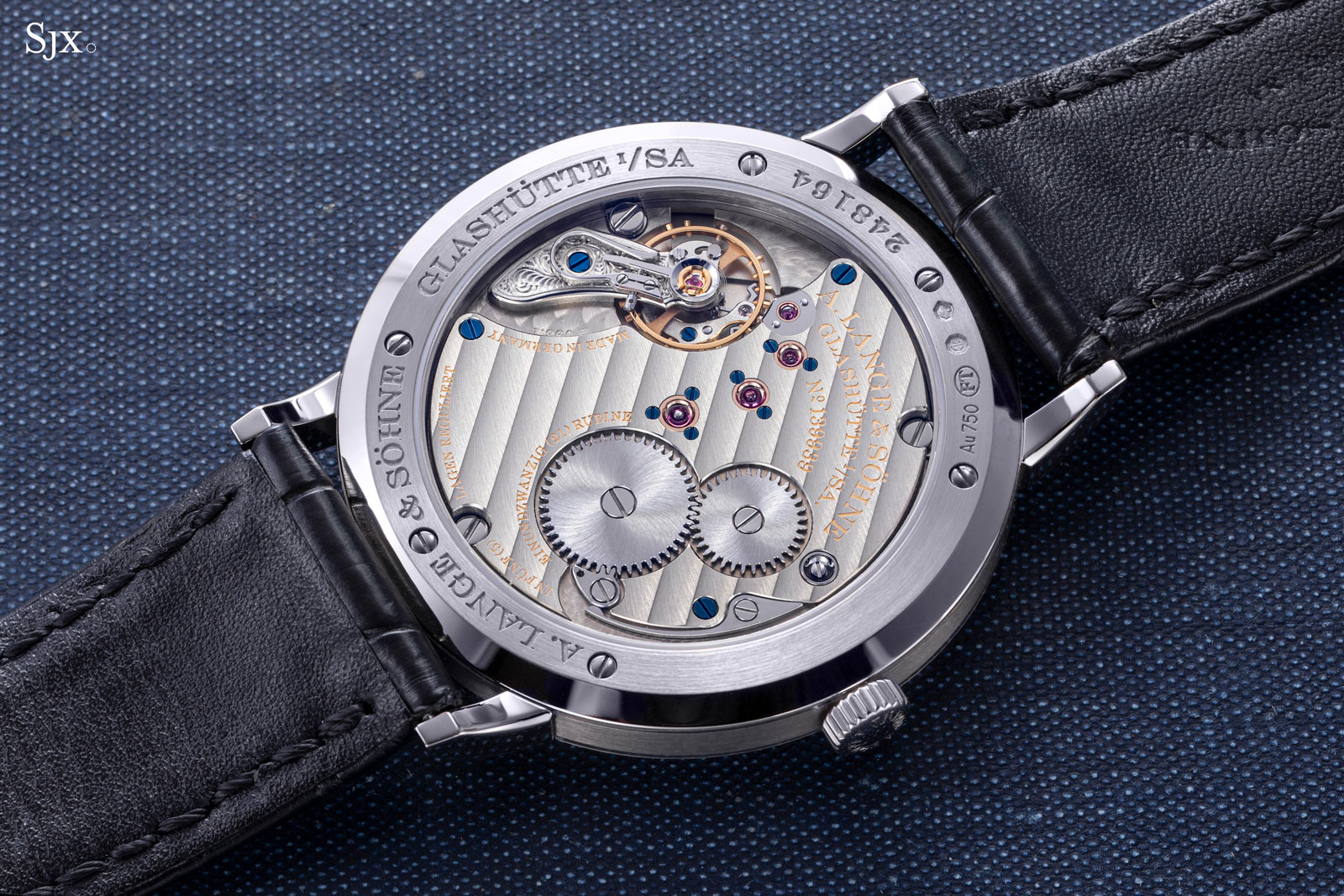
Born of skilled labour in Glashütte
The case
The 18k white gold case of the Saxonia Thin consists of three parts: bezel, case band, and case back. It measures 37 mm in diameter and 5.9 mm thick. It appears simple, but closer examination reveals a variety of interesting details.
The most prominent feature is the horizontally brushed finish on the case band, which contrasts nicely with the highly polished bezel, back, and lugs. The lugs curve downward, hugging the wrist, and feature tapered facets on their outer edges.
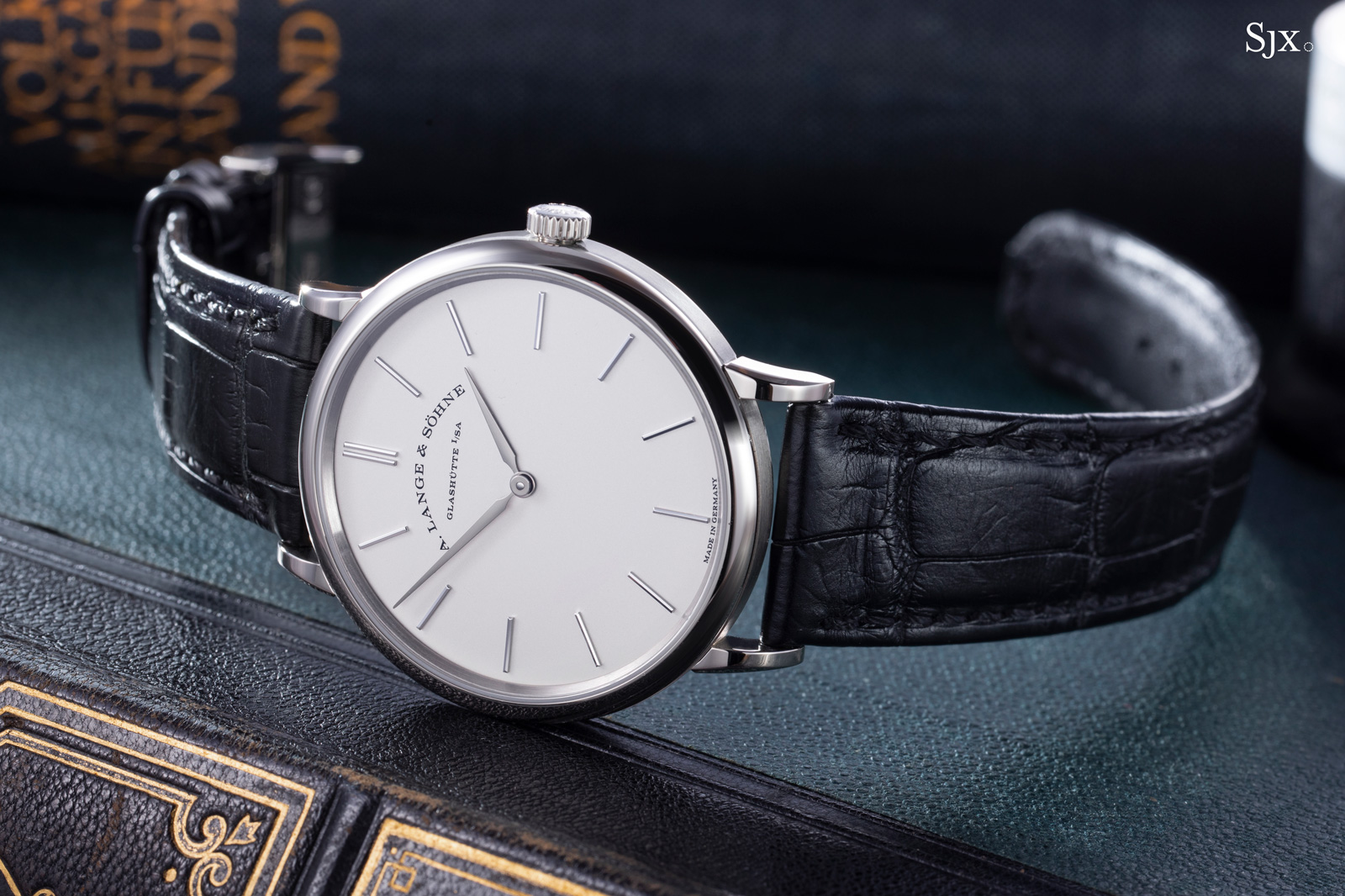
As is typical of Lange cases, the lugs are produced separately and soldered in place. While not as sensuously curved as the teardrop lugs on a Voutilainen, the lugs are nonetheless produced and attached to the case in the same way.
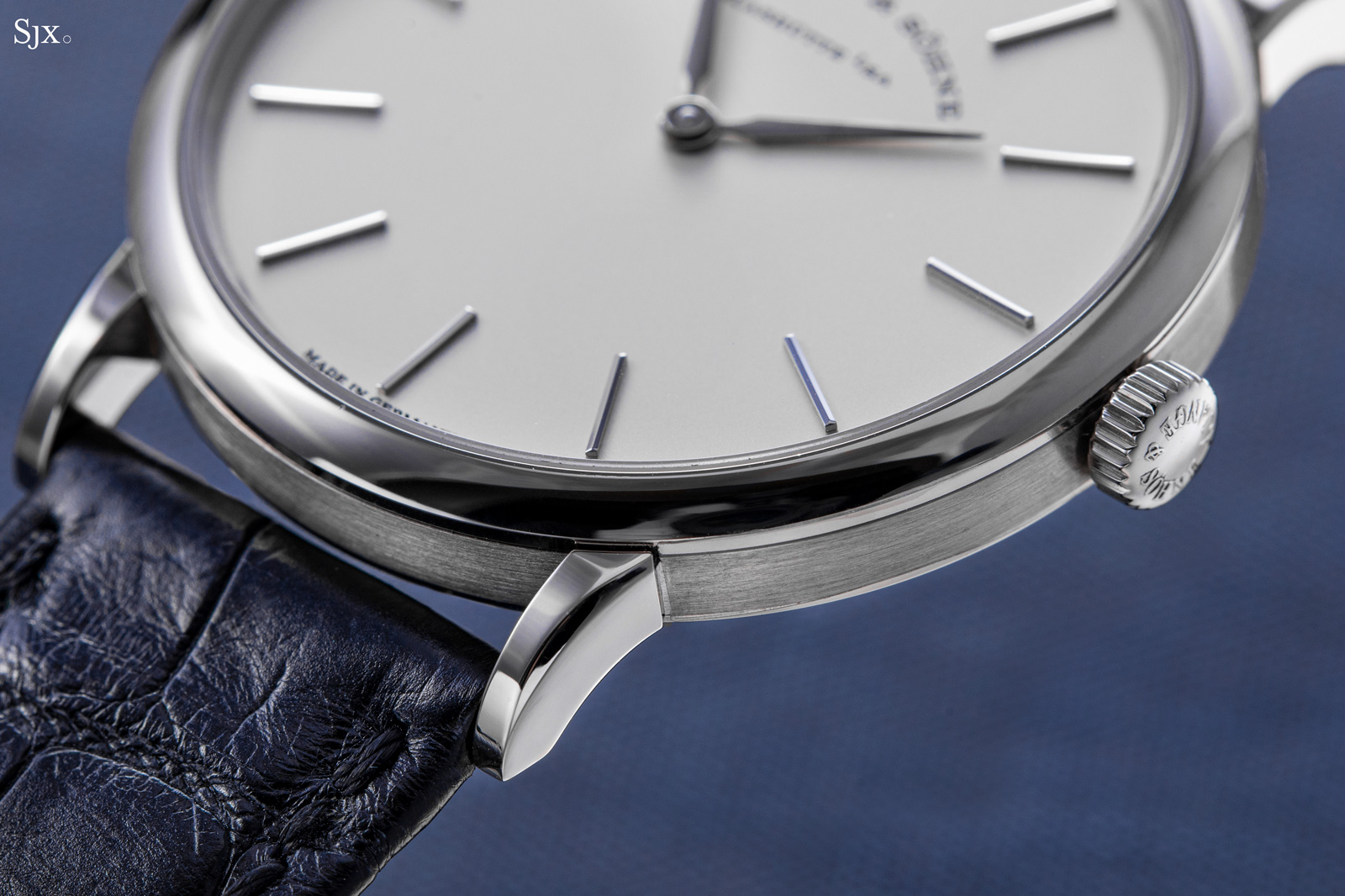
This type of construction is more complex than that of an ordinary one-piece stamped case, but allows for more freedom of design and finer details and finishes. For example, this construction is what makes it possible for the brushed finish of the band to continue uninterrupted deep into the notch where the lug meets the case.
This notch, a Lange signature designed by Günter Blümlein himself, appears on all Lange watches except the Arkade. In a one-piece construction, the brushed finish would have to stop short of the notch.
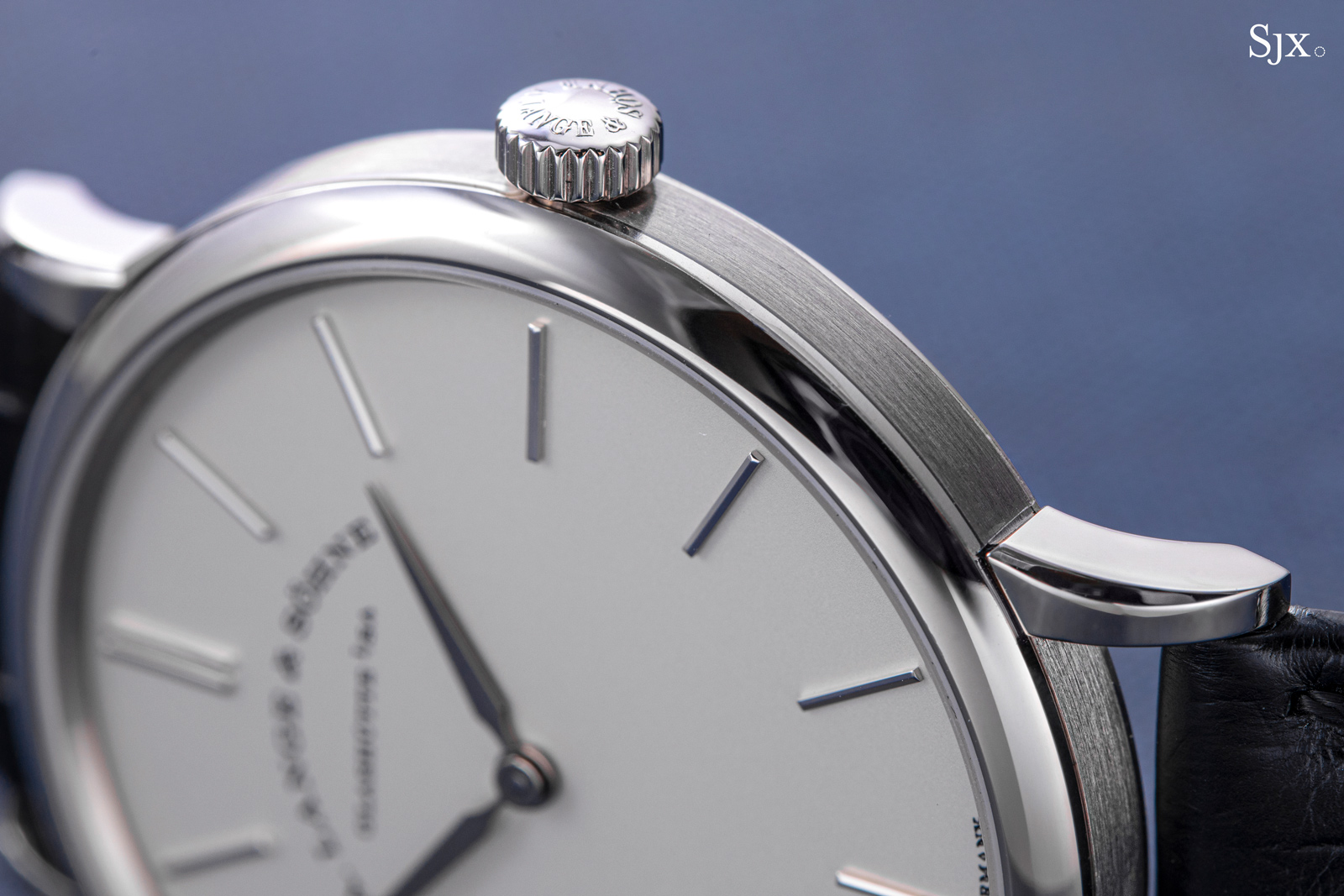
The brushed finish of the caseband contrasts nicely with the mirror-finished surfaces of the bezel, caseback, and lugs
The case is made by Efteor, a small casemaker located in the Haute-Sorne region in the Swiss canton of Jura. Efteor’s maker’s mark is the initials “FT” inside an oval. As this video tour of the Efteor manufacture shows, they supply precious metal and gem-set cases to a variety of brands, including Zenith and Jaeger-LeCoultre.
While Lange is known to source cases from three other case makers, namely SUG, Centror, and Donze-Baume, Efteor’s hallmark can be spotted often enough on Lange watches, including the Datograph Tourbillon Perpetual Calendar and Richard Lange Jumping Seconds.
The case is hallmarked with a St. Bernard’s head, the official assay mark of Switzerland. Upon magnification, a tiny letter code “J” is visible in the hallmark, indicating that it was assayed by the Contrôle des Métaux Précieux Bâle in Le Noirmont, which makes sense as it’s only a 30-minute drive from Efteor’s facility.
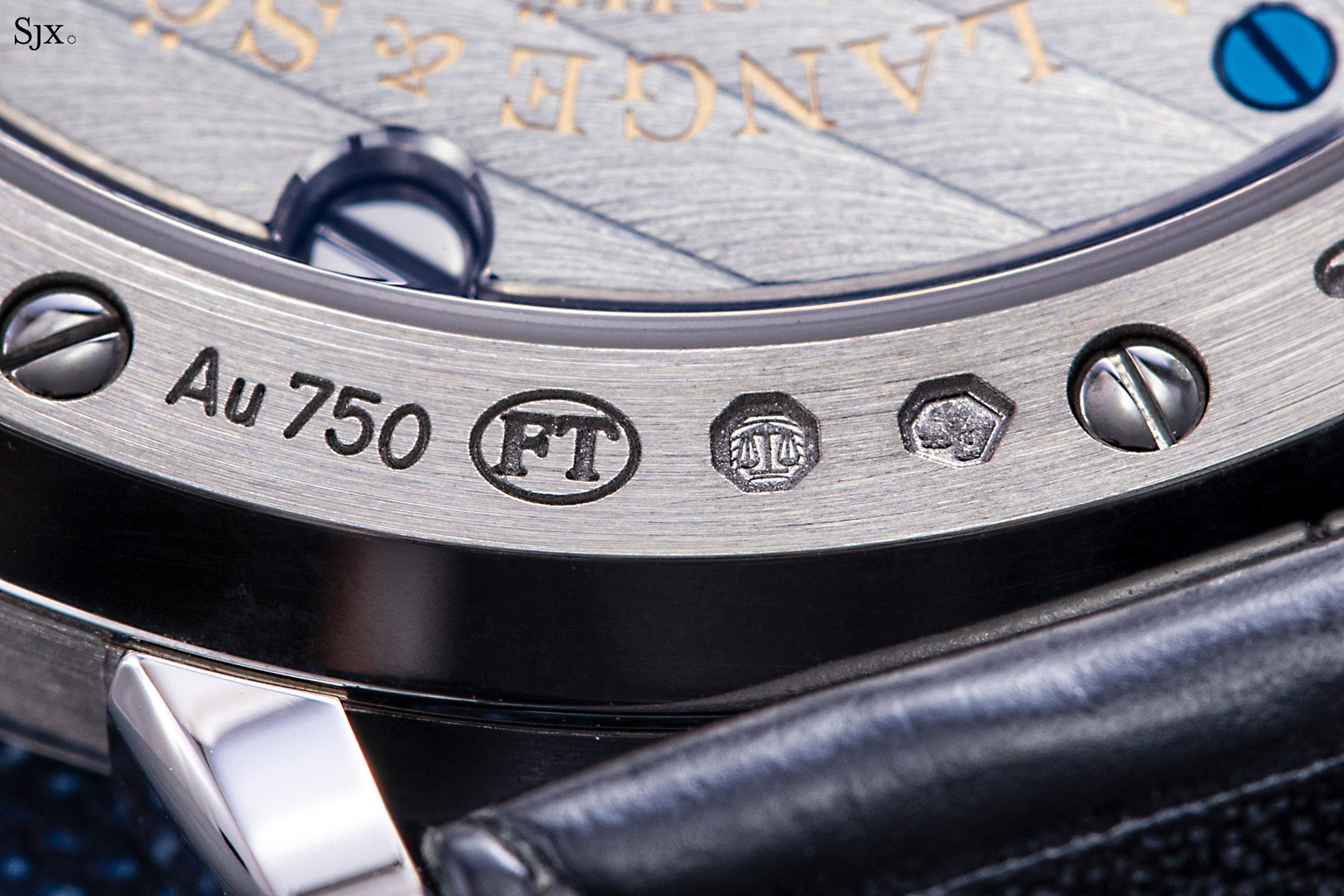
Swiss hallmarks for gold, with the letter code “J” in the neck of the St. Bernard that is invisible to the naked eye
As for the composition of the gold alloy itself, Lange specifies a high proportion of palladium of around 15%, which enables them to avoid having to use rhodium plating to create a silvery-white finish and hide the yellow tinge often seen on white gold of another composition.
This is a benefit to collectors since it means the case will not have to be stripped and re-plated when it needs refinishing. At the time of publication, gold and palladium are both significantly more expensive than platinum, which should make this gold alloy one of the more expensive blends used in the watch industry.
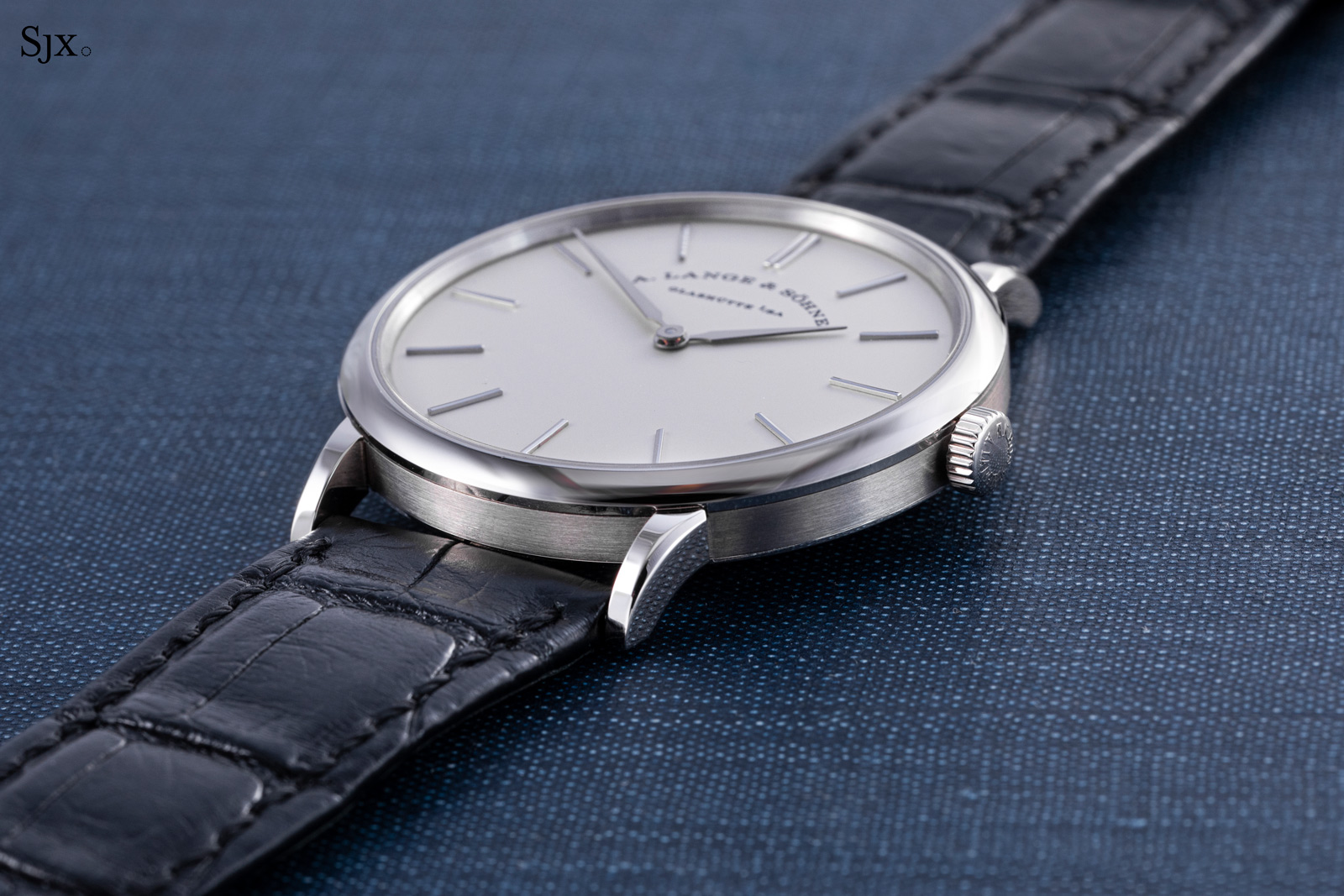
One aspect of Lange’s cases that I always appreciate is the depth and precision of the engraved text on the caseback. This detail is often overlooked, and lends a kind of gravitas that’s missing from watches with laser-etched caseback text like the Seiko Credor Eichi II.
The signed crown is also made in white gold, and, more importantly, is of an appropriate size, about 4.5 mm, and texture to make winding the watch a pleasant experience.
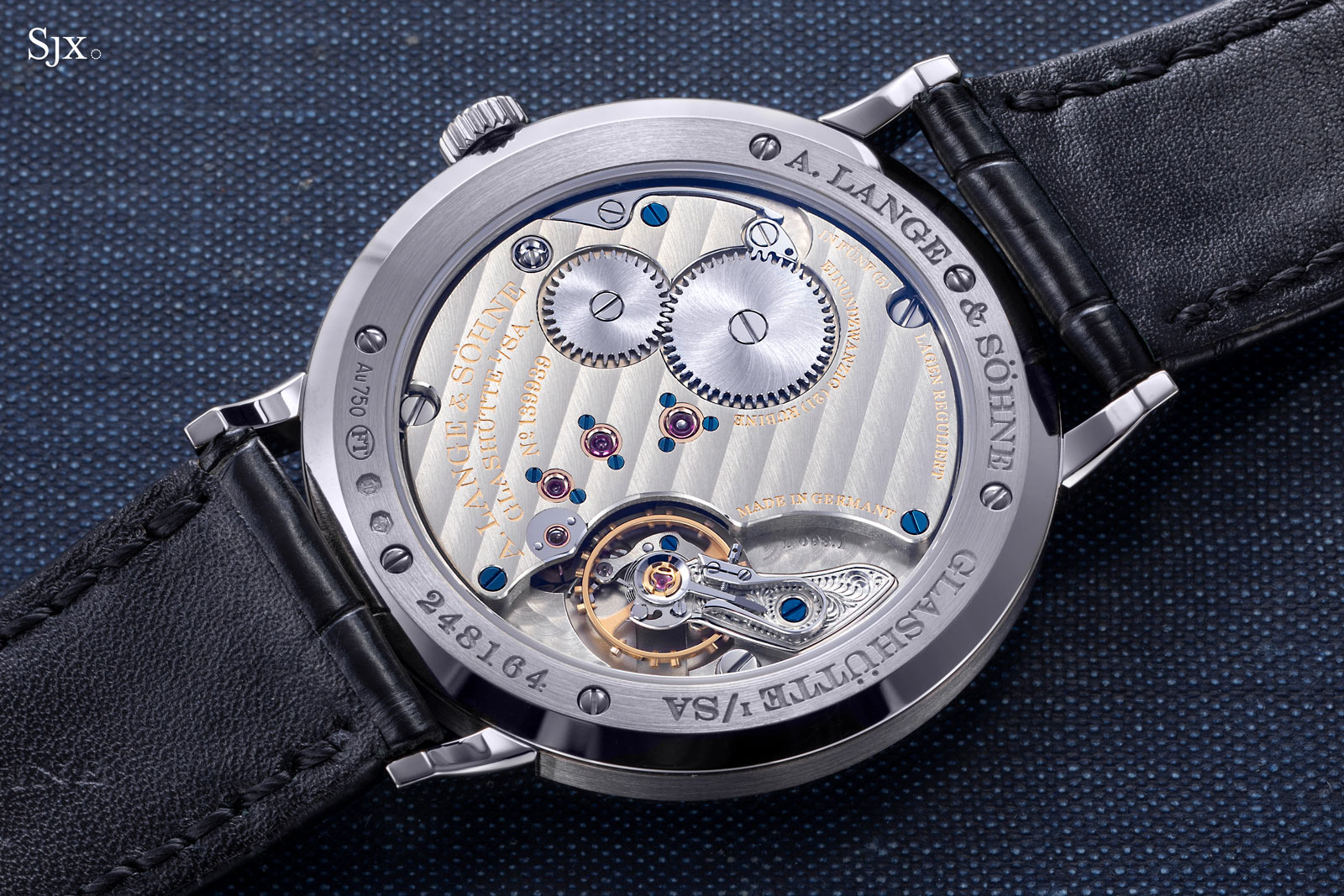
The dial
The dial is crafted from a disc of solid sterling silver that’s galvanised to a matte, silvery finish known as “argenté”.
The dial markers are made of solid 18k white gold, as are the alpha-style hands. For a bit of extra shine, the hands are rhodium plated.
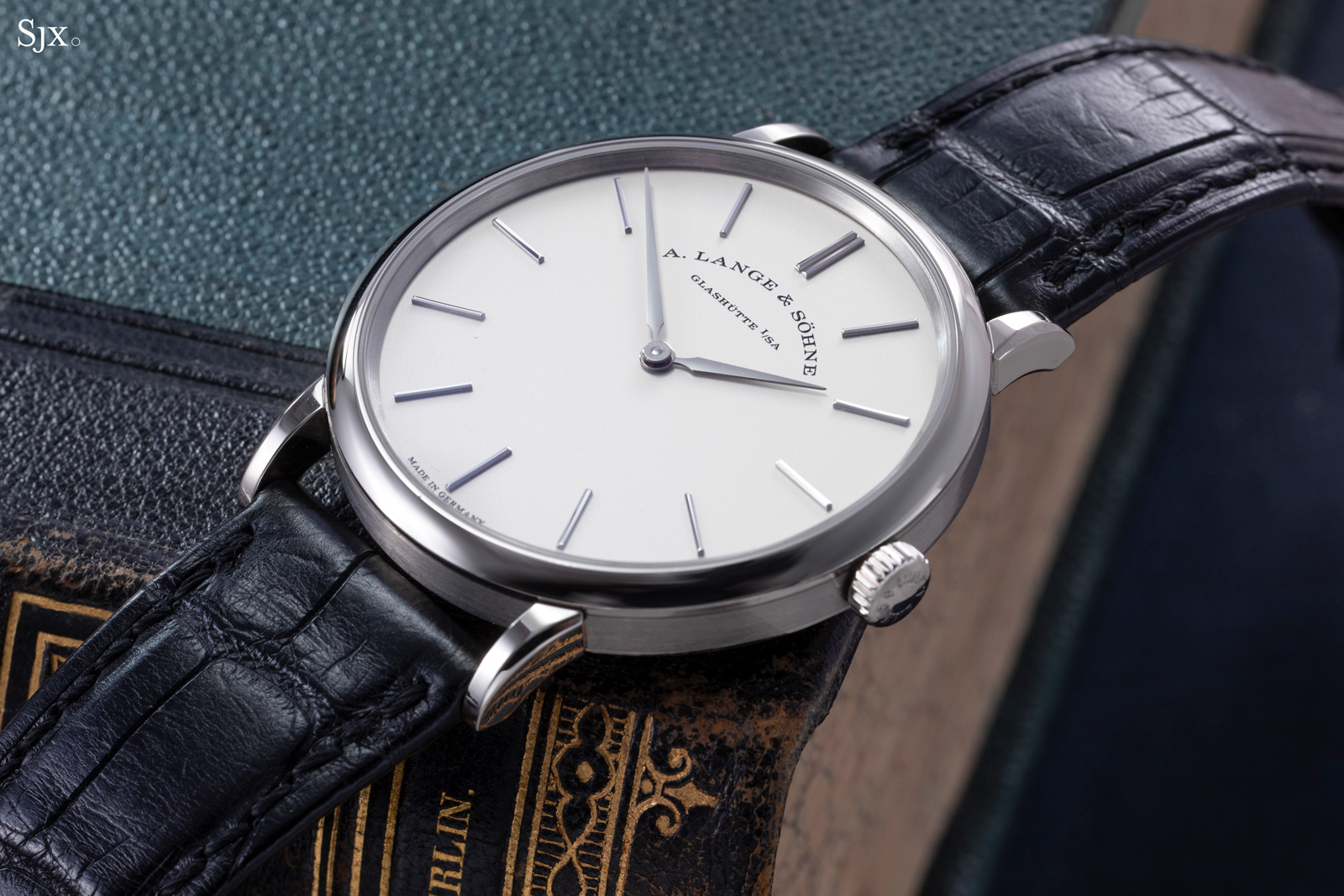
Given that Lange is focused on movements, they usually work with suppliers for cases and dials. I say usually, because Lange does produce some exceptional dials in-house, primarily for the Handwerkskunst editions that are heavy on artisanal decoration like engraving and enamelling.
For the Saxonia Thin, I suspect the dial is produced by Metalem in Le Locle, though this is not confirmed. Metalem is an elite producer that supplies dials to brands like Chopard, Audemars Piguet, and, probably most famously, Philippe Dufour.
From a design standpoint, the dial is the simplest design Lange has produced. But there’s more going on than first meets the eye.
For example, each dial marker is double-faceted. As can be seen below, the markers are faceted along their length, and also slightly across the ends. They also stand up quite high from the dial surface.
The overall effect is that they gleam brilliantly and cause the dial to change its personality depending on the light. The brilliant finishing of the hands and dial markers makes it easy to read the time in low light, despite the fact that no lume is used.
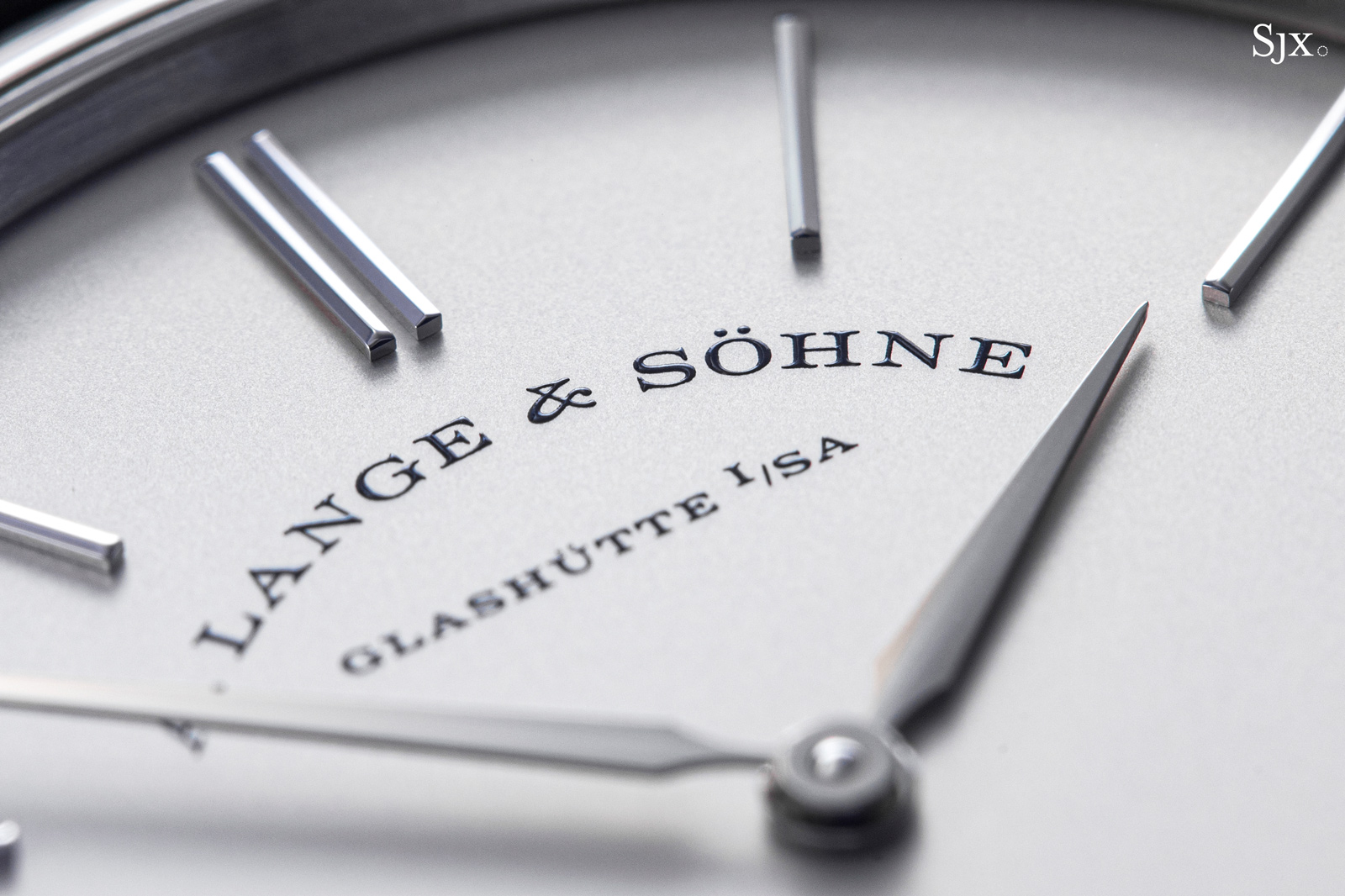
The double-faceted hour markers gleam brilliantly.
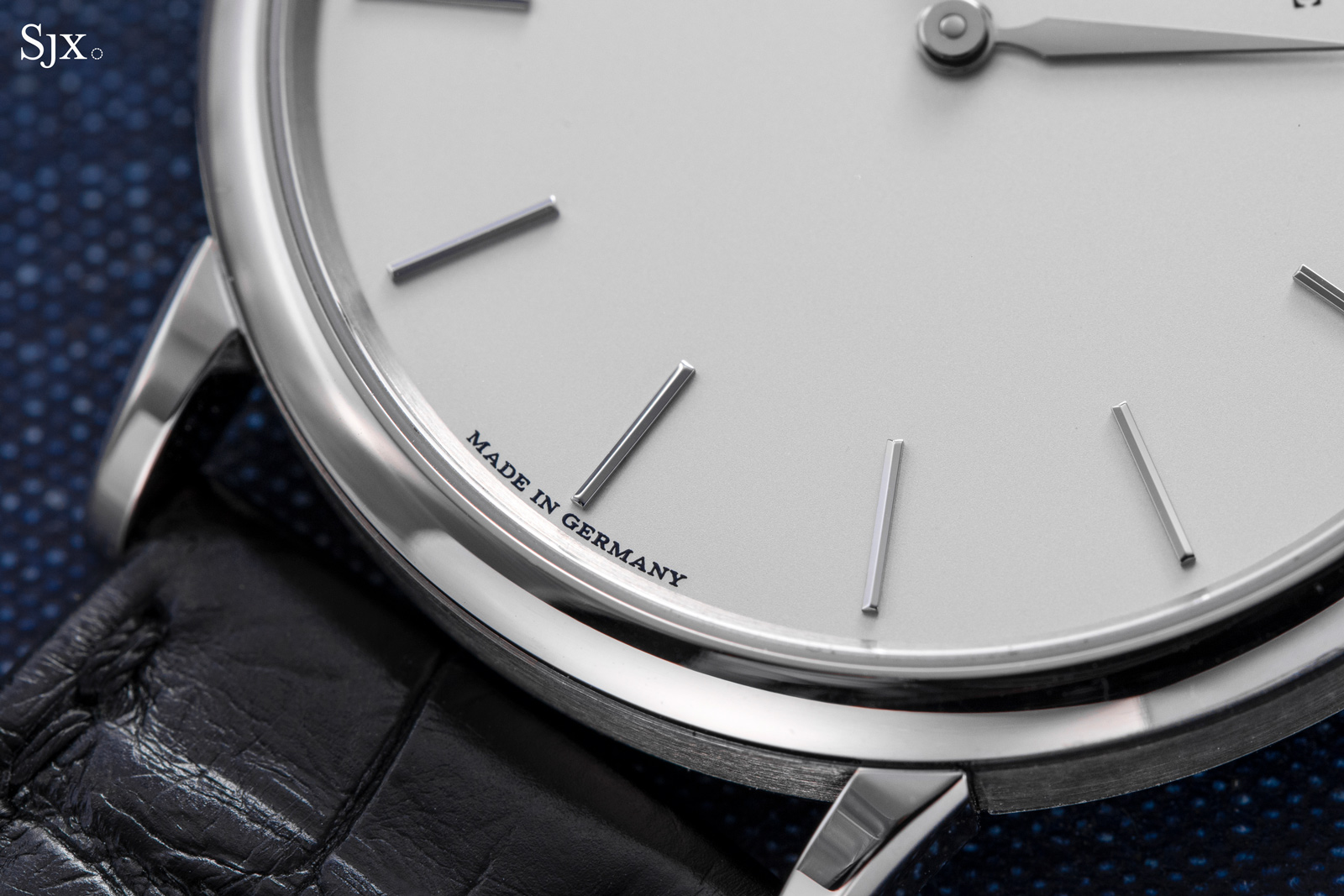
The typography
I’m not alone in my appreciation of Lange’s thoughtful use of typography. The brand uses its own bespoke version of Engravers, a typeface designed by Robert Wiebking in 1899.
The designer responsible for Lange’s unique riff on this classic font was Reinhard Meis, a watchmaker, designer, and historian who worked closely with Günter Blümlein to design the first collection of Lange watches between 1990 and 1994. This choice of typeface suits the character of the watch perfectly, being both dignified and distinctive.
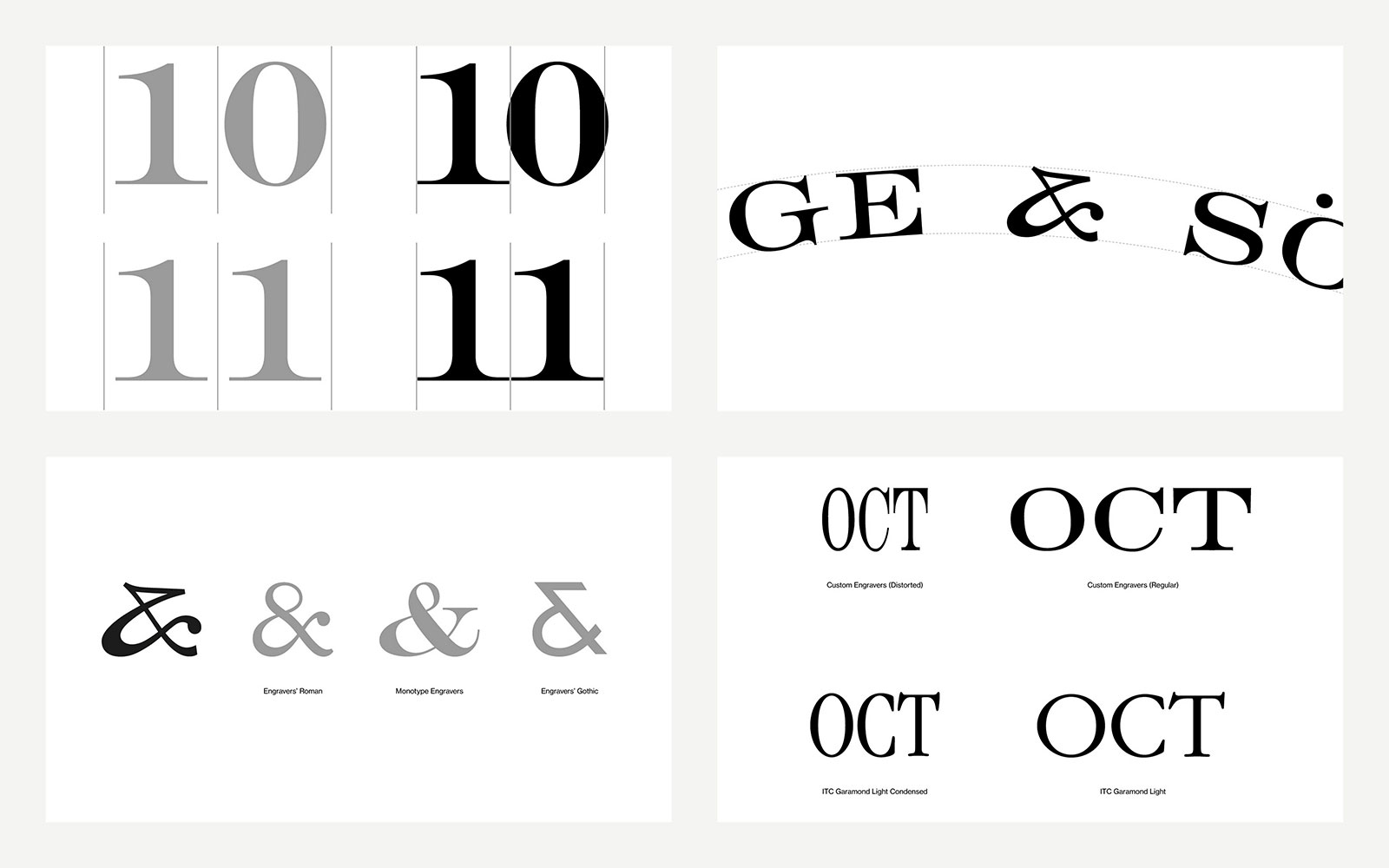
Attention to detail is evident in Lange’s typographic choices. Image – &Larry
I especially like the flat-topped ampersand, and will point out that this flourish is replicated in the engraving on the movement (though not on the caseback due to size limitations). This might seem like a given, but it’s quite uncommon to have the typeface on the movement match the typeface on the dial. Vacheron Constantin and Patek Philippe, for example, often use one typeface for the dial, and a completely different typeface on the movement, even when there’s plenty of space to get it right.
In an industry that often bungles these kinds of small details, Lange’s consistency stands out.
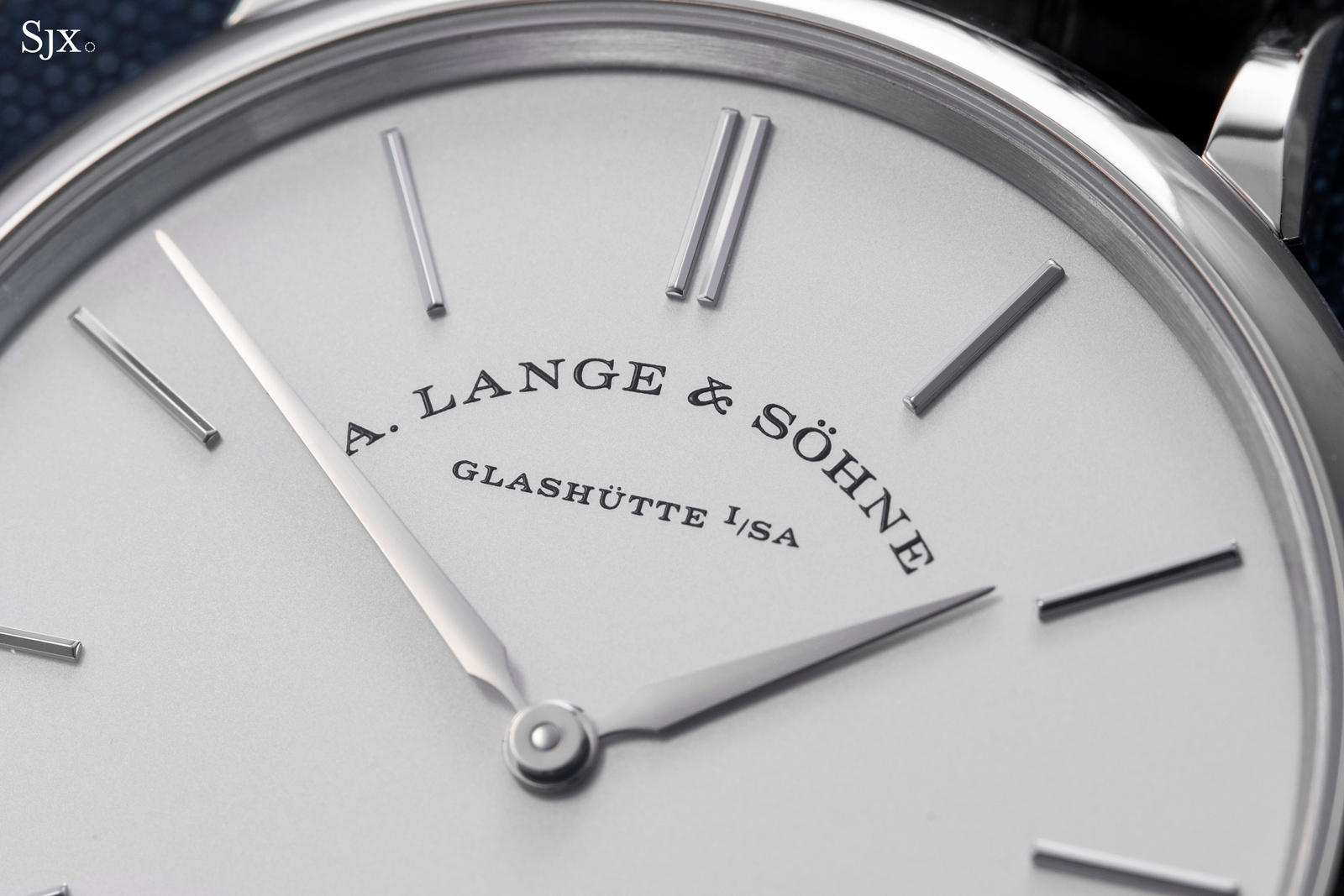
The dial printing is done using multiple layers of ink for a thick, domed appearance at certain angles. The edges of the printing are extremely fine and look crisp even under magnification.
The simplicity of the Saxonia Thin dial really makes the logo pop, and serves as an ideal canvas for appreciating the nuances of the typography.
The strap
The strap is made by Camille Fournet using CITES-compliant alligator leather from the United States. Camille Fournet is a renowned manufacturer of leather goods, and supplies watch straps to many haute horlogerie brands like Patek Philippe and Jaeger-LeCoultre. This video tour of the Camille Fournet workshop in Tergnier, a small town north of Paris, provides insight into the production process.
The strap is 19 mm at the lugs and features a heavy 18k white gold pin buckle in the classic Lange style.
While I understand the appeal of folding clasps, I prefer the comfort and simplicity of a pin buckle. Not only do I tend to find pin buckles more comfortable, but they are more convenient for the Wolf vault trays I use in my watch box. And of course, they make it easier to get an unobstructed view of the movement.
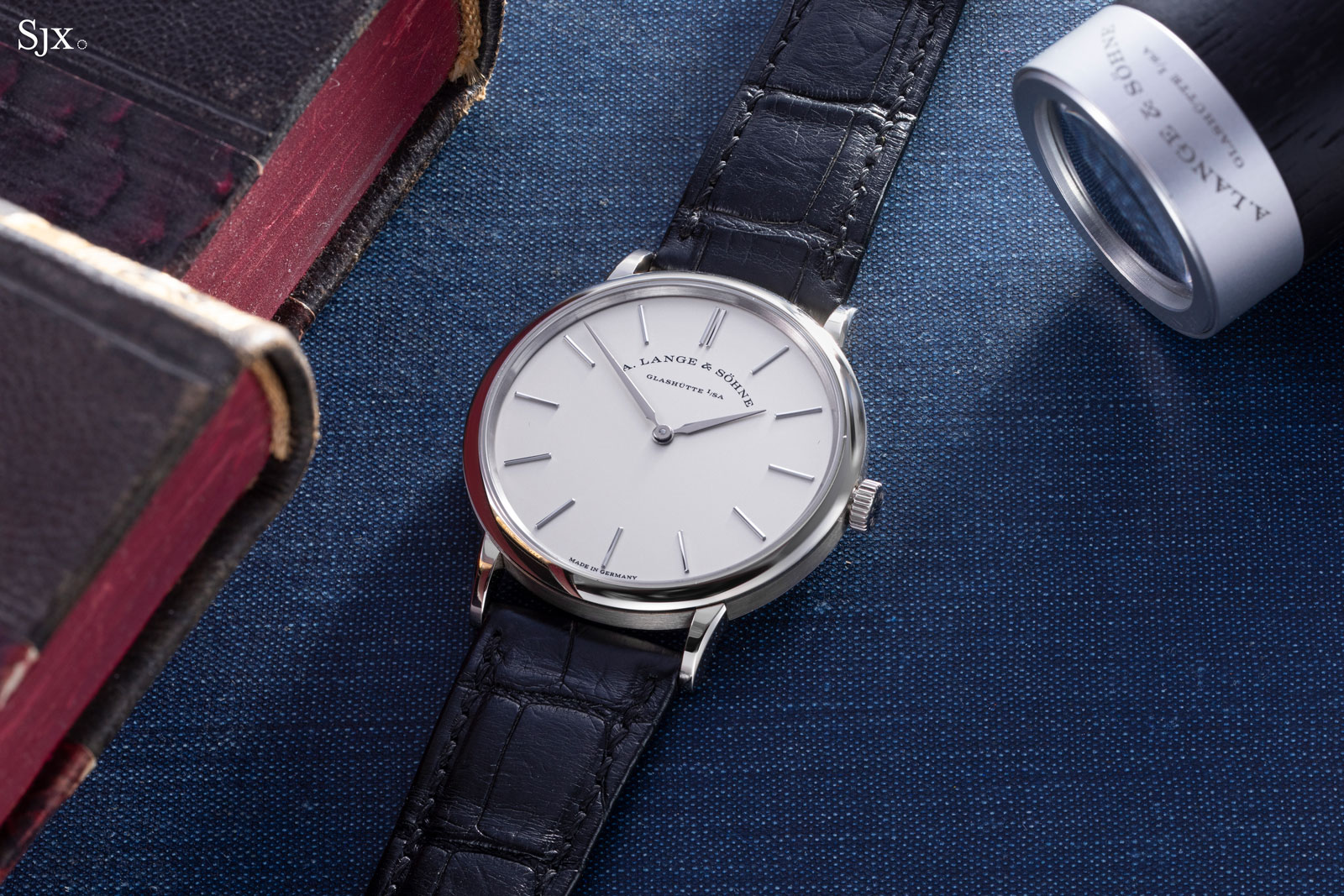
The lining of the strap feels very robust and has held up well to the rigors of daily wear over the past few months.
For the purpose of this review, I’ve stuck to the black strap that came with the watch, but I think it’s worth noting that the watch’s neutral colors and austere design should suit a variety of strap colours and textures.
The movement
“The impressions received in looking at a Lange watch for the first time are of a sturdy, three-quarter plate watch with exposed winding wheels, a balance which is very much bescrewed, a decorated balance cock and the screws beautifully blued. Further examination discloses features not found on contemporary watches made elsewhere than in Glashütte.”
– Major Paul M. Chamberlain, It’s About Time, 1941
The movement is clearly the star of the show in the Saxonia Thin. Compared to the austere dial and simple case, the L093.1 positively bursts with character.
All the quintessential Lange hallmarks cited by Chamberlain are present – a fact is worth exploring further. It’s a testament to the brand’s commitment to its historical roots that its modern wristwatch movements embody so many of the distinctive characteristics of the antique Lange pocket watch movements.
In my opinion, these historical hallmarks confer a level of legitimacy that’s missing from many other revived historical brands. For example, I doubt that John Arnold, were he alive today, would recognize the work of the modern Arnold & Son brand as having much in common with his own work.
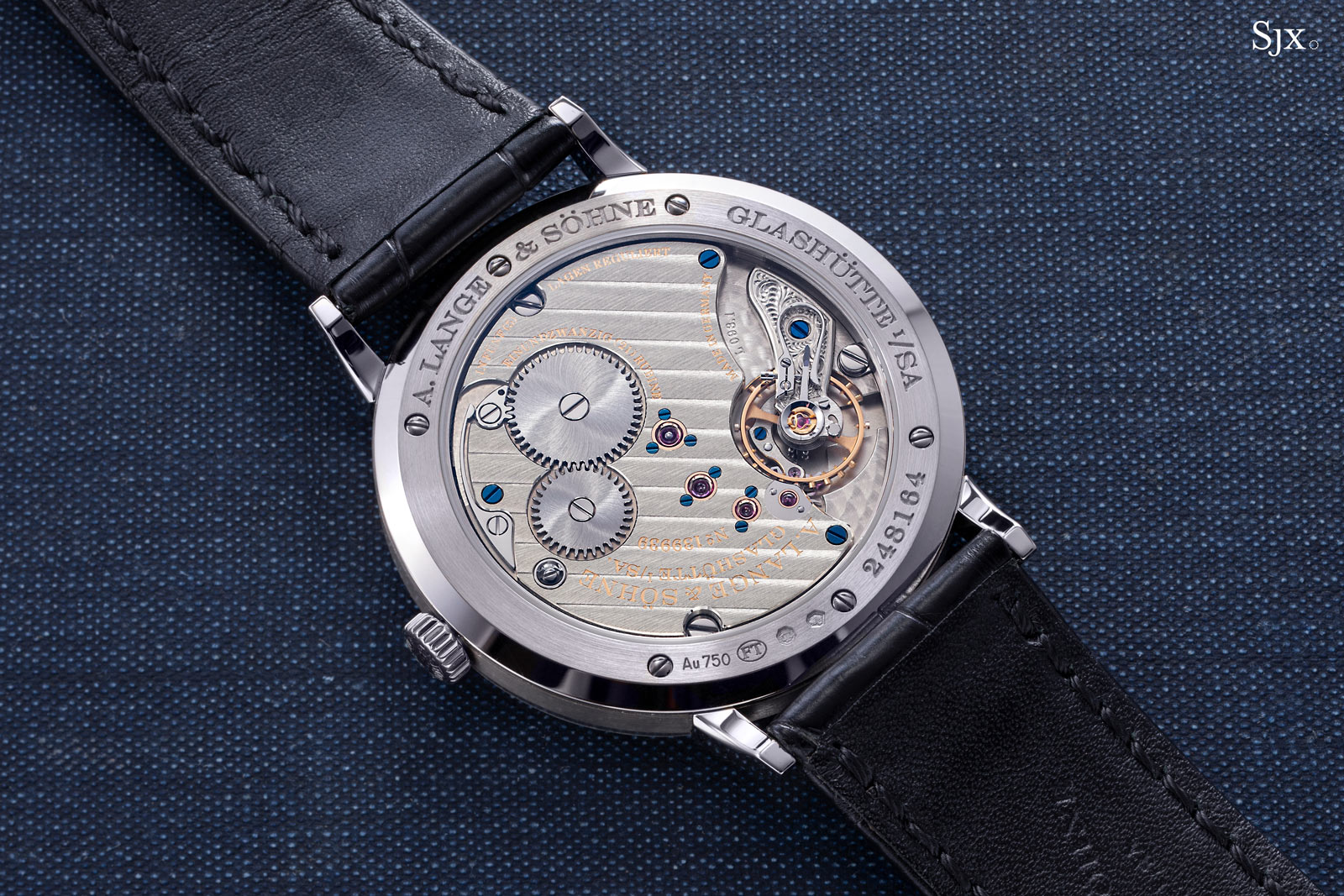
Chamberlain, were he alive today, would have no difficulty recognizing the L093.1 as the work of A. Lange & Sohne.
Development of the L093.1 started in 2009, as indicated by the “09” in the movement name, and the movement debuted in 2011. The movement is 28.8 mm in diameter, a size that fills the case nicely, and offers a power reserve of 72 hours.
While it’s arguably Lange’s simplest movement, it’s also the brand’s thinnest at only 2.9 mm high. And as a collector friend of mine likes to say, “thinness is a complication” – especially if it works well and keeps good time.
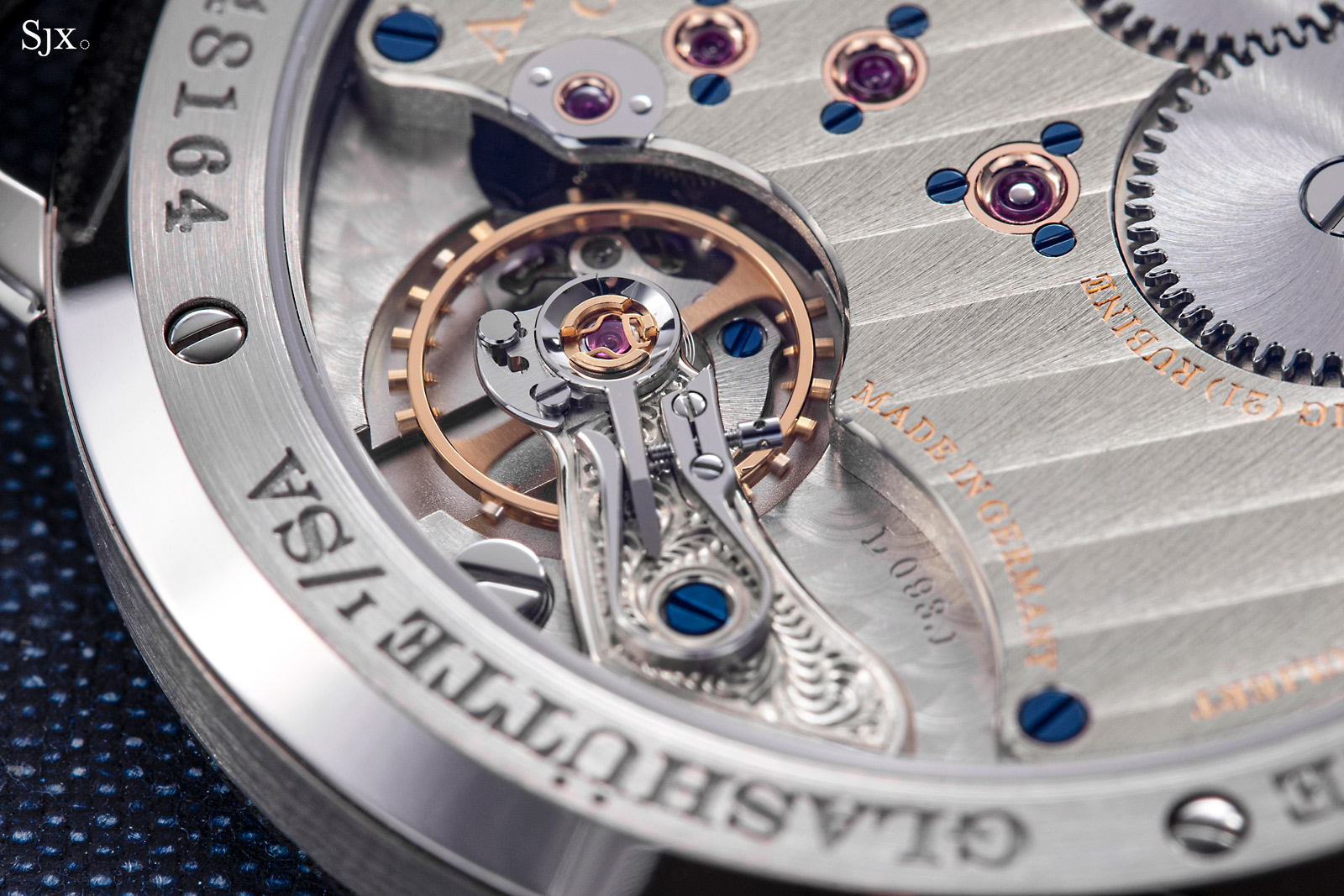
Surprising depth for a movement 2.9 mm thick. The mirror-finished anglage and steelwork are immaculate.
What I found most surprising about the movement is its sense of depth. The small canyon between the edge of the three-quarter plate and the balance cock creates visual interest and draws the eye to the mirror-polished bevel that runs the length of the top plate.
Even the jewels contribute to the sense of depth, sitting deeply within mirror-polished gold chatons. They are so finely polished I can see my reflection when I view them with a loupe.
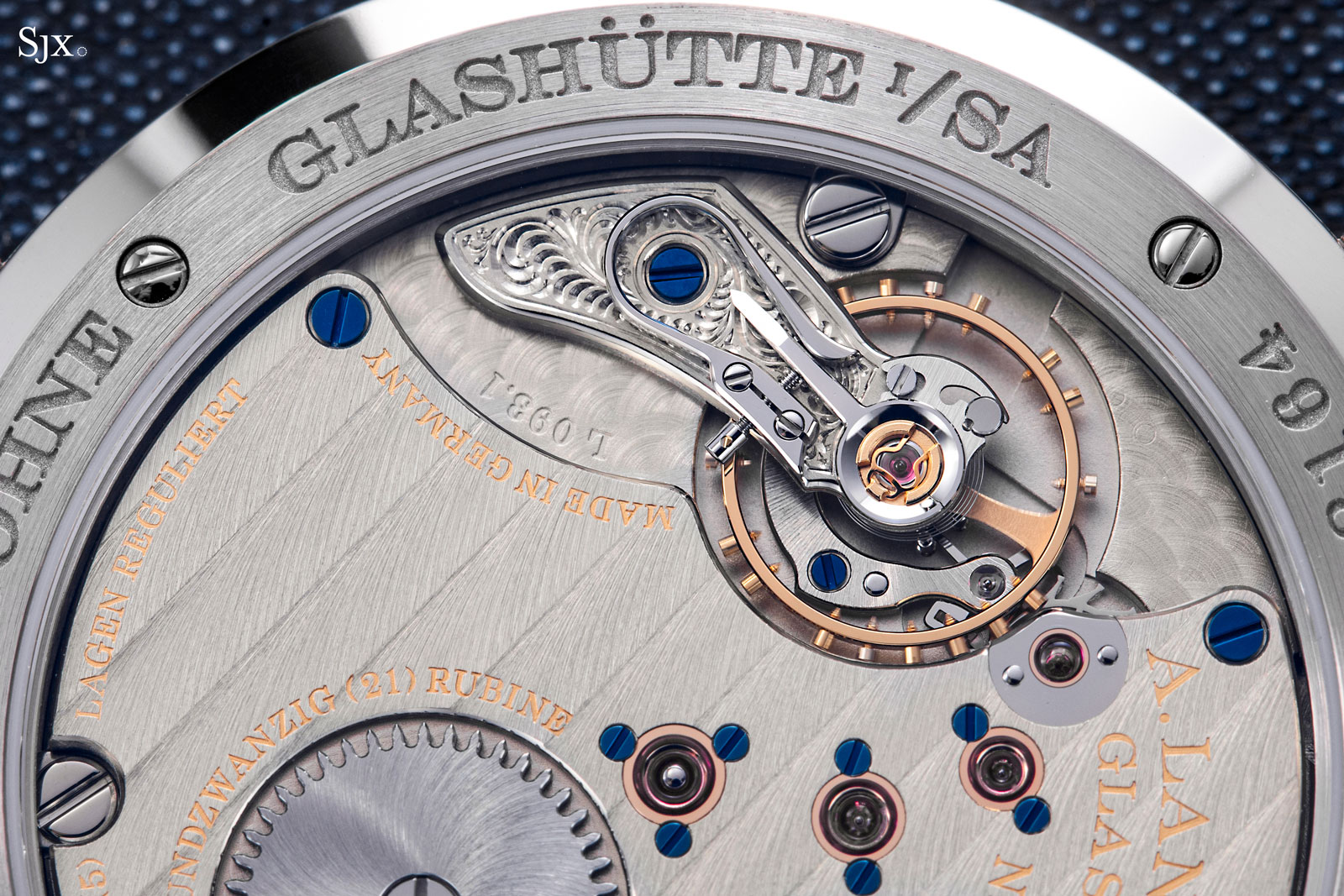
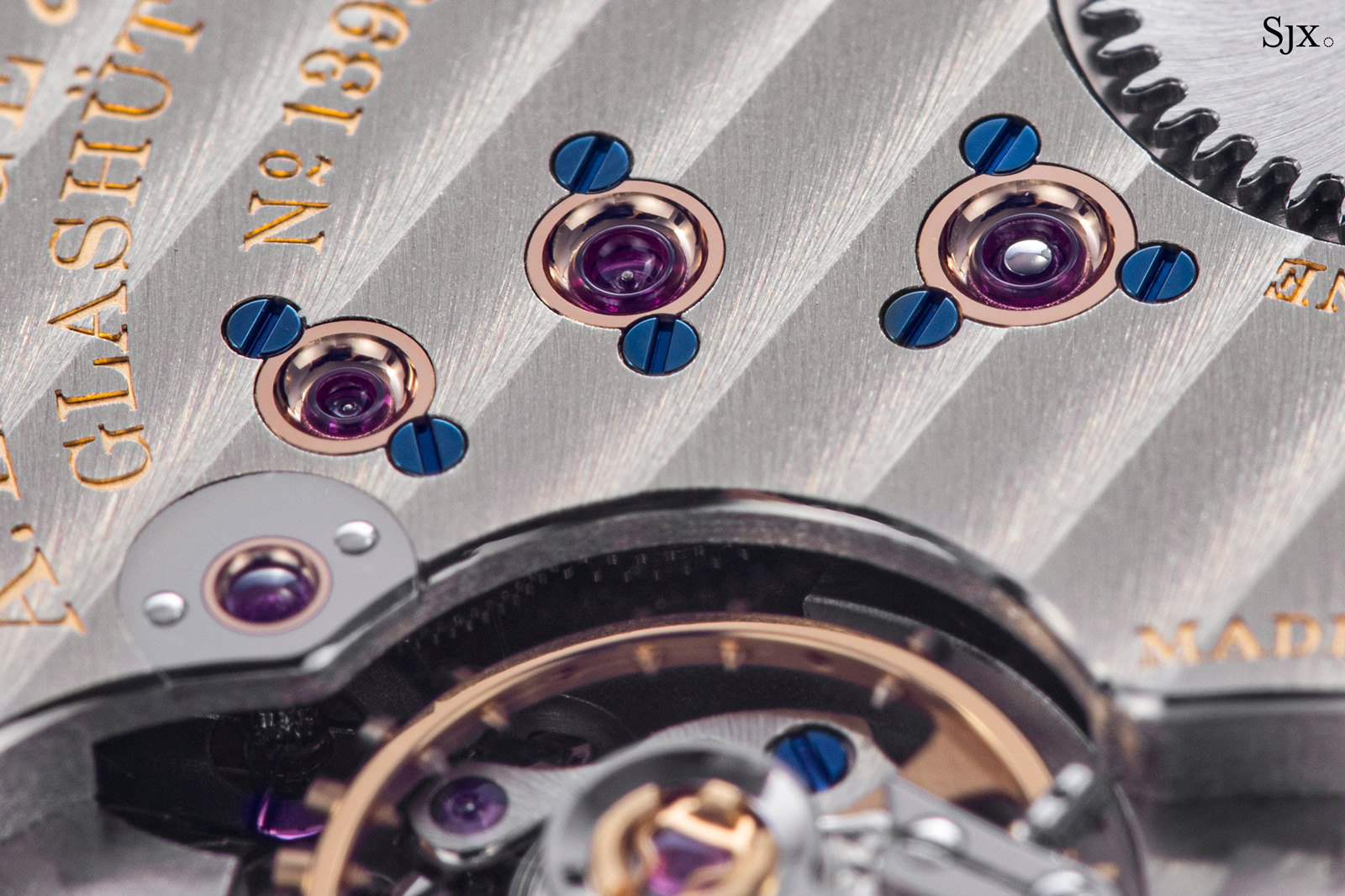
An angled shot, revealing the depth of the jewels in their gold chatons.
On the topic of the gold chatons, they do not serve a technical purpose in modern watchmaking. Once used to help fit delicate and irregularly cut natural rubies, chatons were obsolete by the time the industry transitioned from pocket watches to wristwatches in the early twentieth century.
It wasn’t until Lange started using them in 1994 that they were regularly used in wristwatches. Given how many brands use chatons today, it’s easy to lose sight of this, but the gold chatons were a major stylistic differentiator for Lange when the brand was relaunched in 1994.
Today, chatons are mostly used out of respect for specific, regional styles of movement finishing, primarily by Saxon brands like Lange, Lang & Heyne, and Moritz Grossmann, but also by Roger Smith in Britain (because 19th German watchmakers were inspired by 18th English watchmaking).
Personally, I feel like the chatons are a worthy embellishment, and add a great deal of character and interest to the movement.
German silver
Famously, Lange’s movement bridges are made from untreated German silver, also known as maillechort, an alloy of copper, nickel and zinc. There are pros and cons to using this material in a watchmaking context, as opposed to the more common rhodium-plated brass favoured by the Swiss.
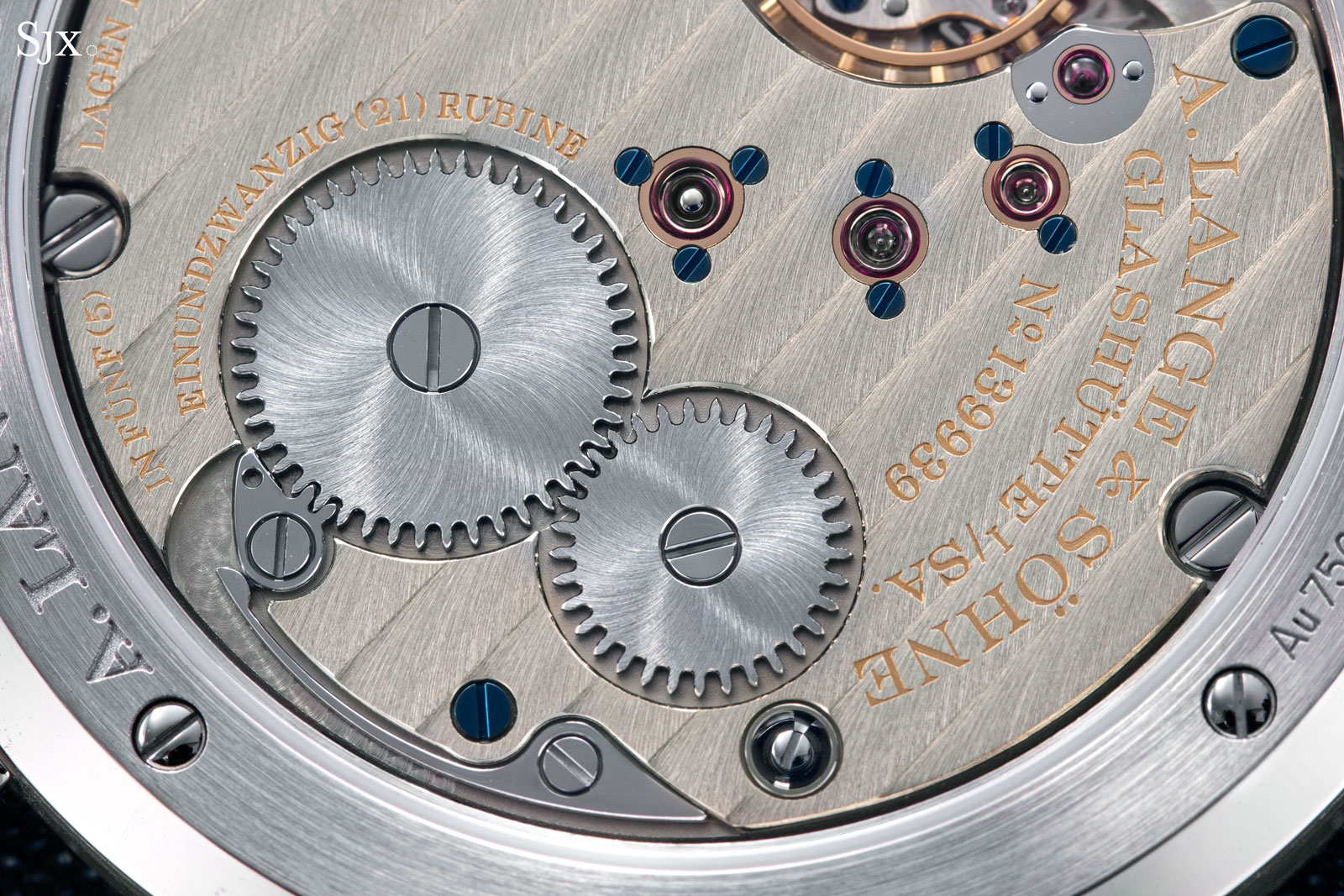
On the positive side, German silver is a stronger and more corrosion-resistant material than brass. In its untreated form, it will develop a protective – and beautiful – honey-hued patina over time. And its hardness makes the metal a great base for finishing and decoration.
The downside is that the material is easily scratched and can darken from contact with ungloved fingers due to the oils in the skin. This means that extra care is required during production, assembly, and servicing, something that Anthony de Haas discussed during Watches & Wonders this year.
Winding and setting
One of the joys of the Saxonia Thin, and any Lange watch for that matter, is the tactile sensation of the winding. It is very pleasing – you can feel each polished tooth of the ratchet wheel slip beneath the click. The winding pressure is even and consistent all the way to full. Lange clearly puts emphasis on making sure the winding feel is delightful, and this is evident across the entire collection.
Another important but often overlooked dimension of movement quality is the ability to set the time precisely. In some movements, the minute hand will move slightly when the crown is pushed in after setting, making it difficult to set the time accurately. The Audemars Piguet cal. 3120 is infamous for this, and Moritz Grossmann has actually gone so far as to develop a push-button restart system to ensure accurate setting.
I’ve been vigilant for any sign of this in the L093.1, but in my usage so far the hands have remained completely steady when I push the crown back in after setting the time. This is a very good thing and goes to show that the watchmakers at Lange haven’t forgotten that a watch is fundamentally a timekeeping instrument.
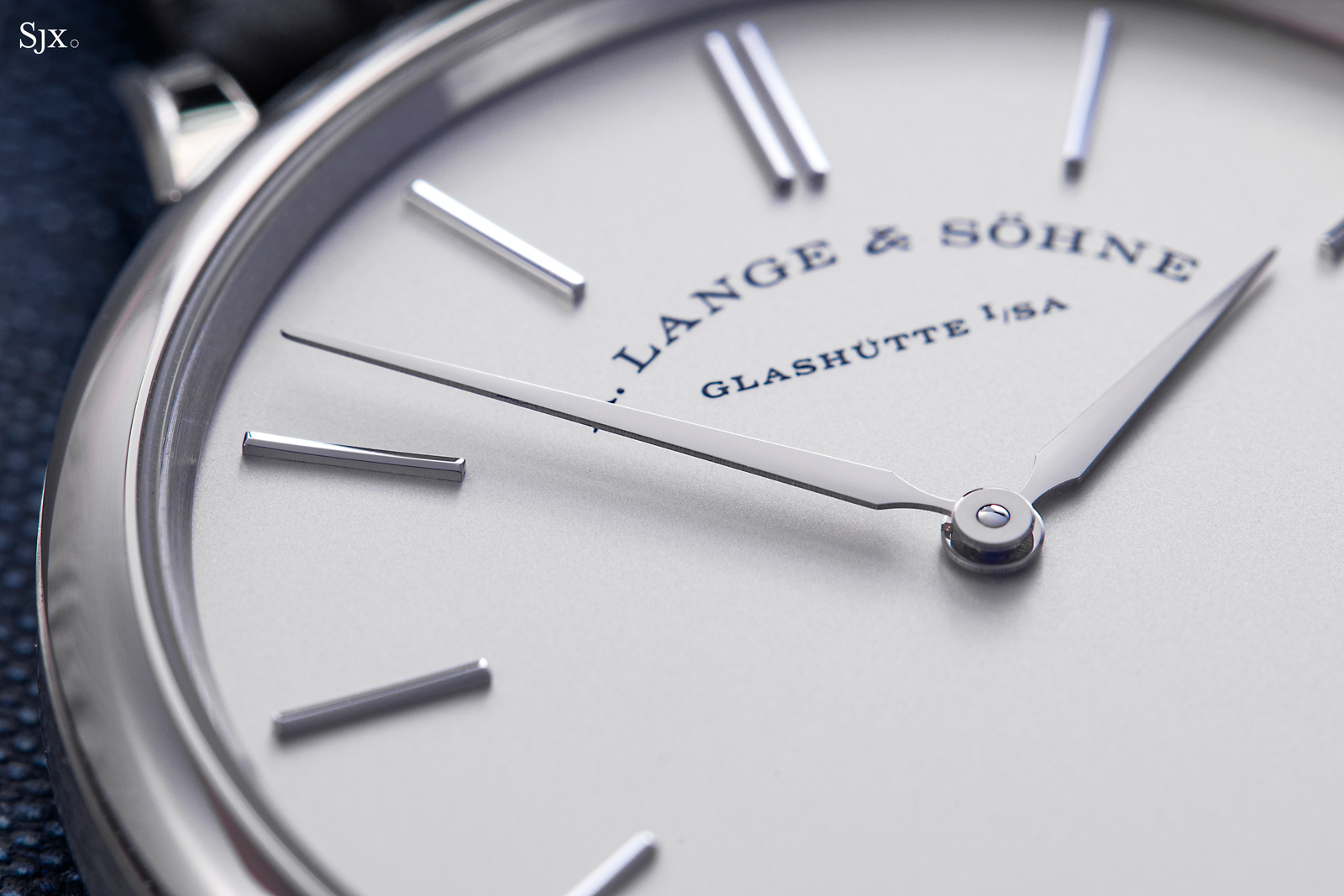
Setting the Record Straight: the free-sprung balance
There is a common misconception that the L093.1, along with many other Lange calibres, is not free-sprung. This misconception appears to stem from the presence of a swan neck fine adjustment device, a feature that, historically, was exclusively used to control the position of a curb-pin regulator.
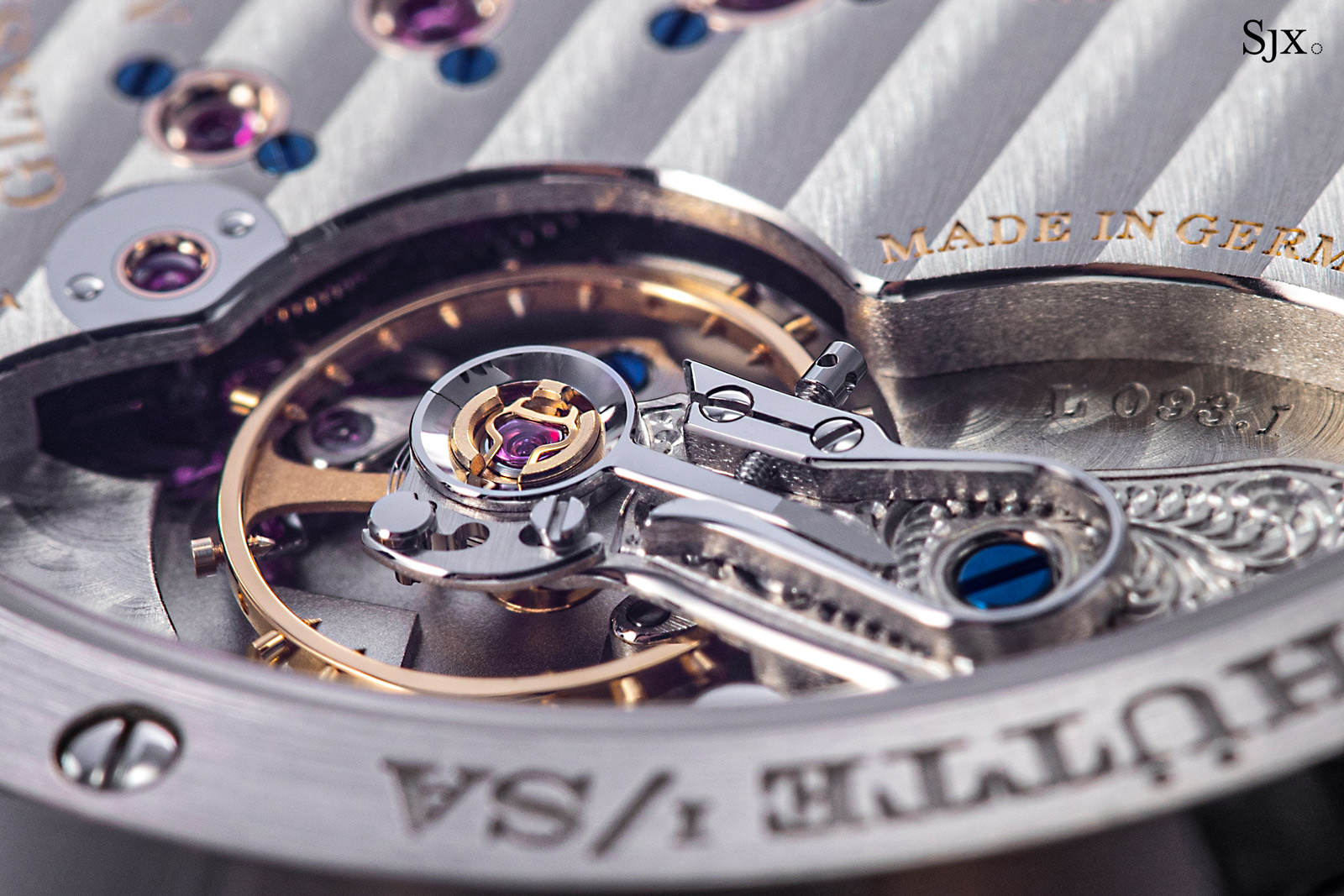
The finely finished steelwork of the swan neck fine adjustment system in the L093.1. Not only is it black-polished on its top surface, it’s also carefully anglaged along its entire length.
However, in 2006 Lange introduced the L041.2 in the Richard Lange. The L041.2 was the brand’s first movement to feature a free-sprung balance, but it still had a swan neck fine adjustment system. This was done to maintain continuity with the aesthetics of German watchmaking tradition, while improving the chronometric potential of the movement.
Without a curb-pin regulator to manage, the swan neck was repurposed to control the position of the stud holder, which is the attachment point for the hairspring. Many fine watches have a mobile stud holder to improve the ease with which the beat can be adjusted, so this was a natural and elegant solution.
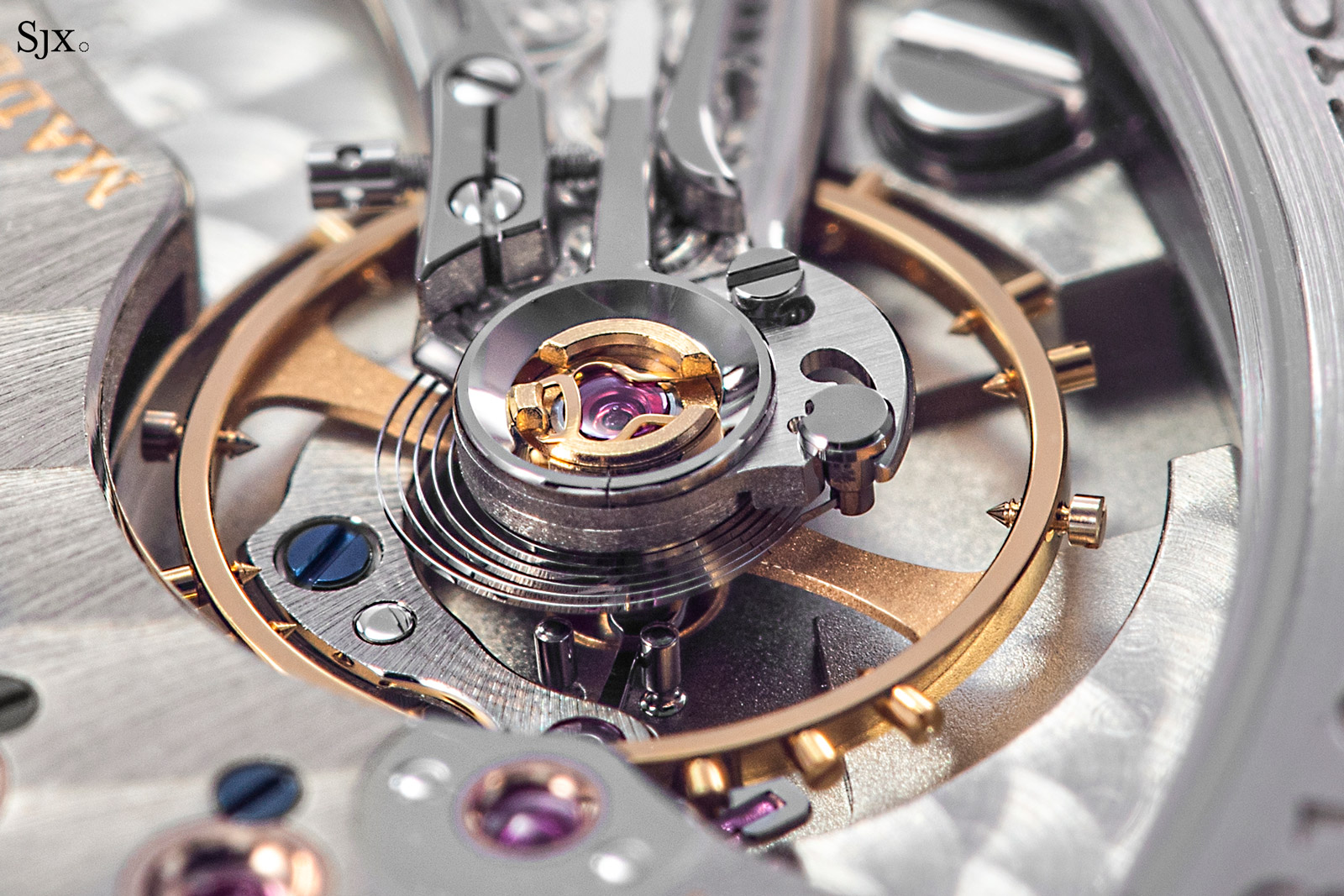
The coils of the hairspring are clearly visible in the cropped image above, undisturbed by curb-pins, all the way back to the stud holder. The screw visible at the top-right is a locking screw that fixes the stud holder in place after adjustment via the swan neck device.
This kind of subtle but thoughtful innovation is a hallmark of Lange. It would have been easier to stick to the status quo and use a swan neck fine adjustment system in conjunction with a curb-pin regulator, an approach taken by fellow German watchmakers like Moritz Grossmann and Lang & Heyne.
But Lange found a way to maintain continuity with the past while implementing a free-sprung balance, a feature universally acknowledged to improve a watch’s chronometric potential. The solution has been rolled out gradually across Lange’s range of movements over the past 15 years, and today curb-pin regulators have all but disappeared from the collection.
Eagle-eyed observers will also note that this solution has since been copied by other brands, notably by Glashütte Original in the cal. 36, and Vacheron Constantin in the cal. 3500.
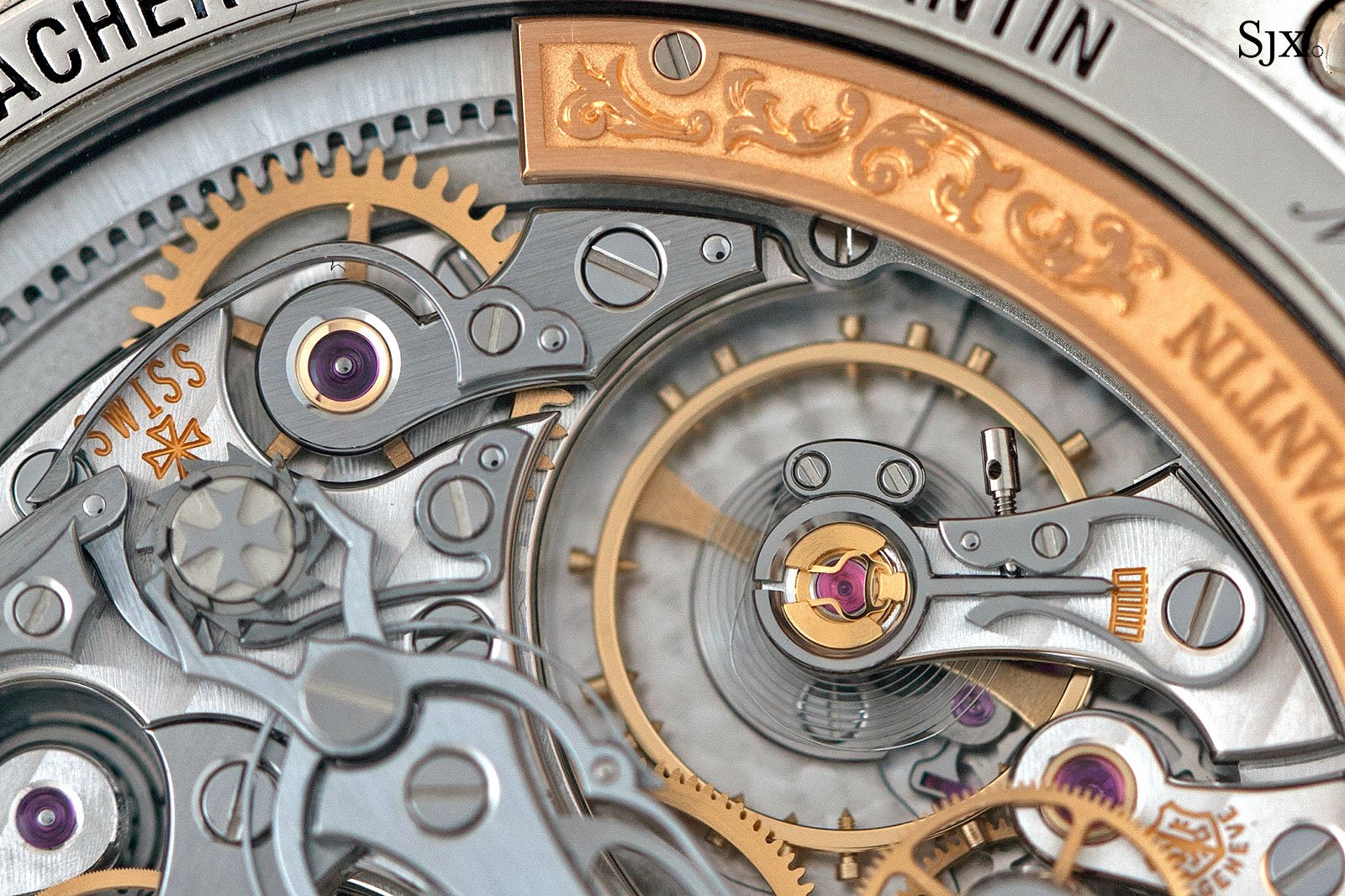
The Vacheron Constantin cal. 3500 emulates the Lange solution for adjusting the position of the stud carrier using the swan neck fine adjustment system.
The Lange hairspring
While we’re on the topic of the free-sprung balance, I think it’s worth noting that the L093.1 features a Lange hairspring, produced in-house at the brand’s manufacture in Glashütte. I was not able to take pictures during my visit to the manufacture, but this video provides a glimpse of the production process.
While we can debate the merits of in-house production versus outsourcing to a specialist, this self-sufficiency is important for a brand like Lange that produces a diverse line-up of movements but in small quantities. Only a handful of brands have managed to bring this expertise in-house and most brands remain reliant on suppliers like Nivarox for these critical components.
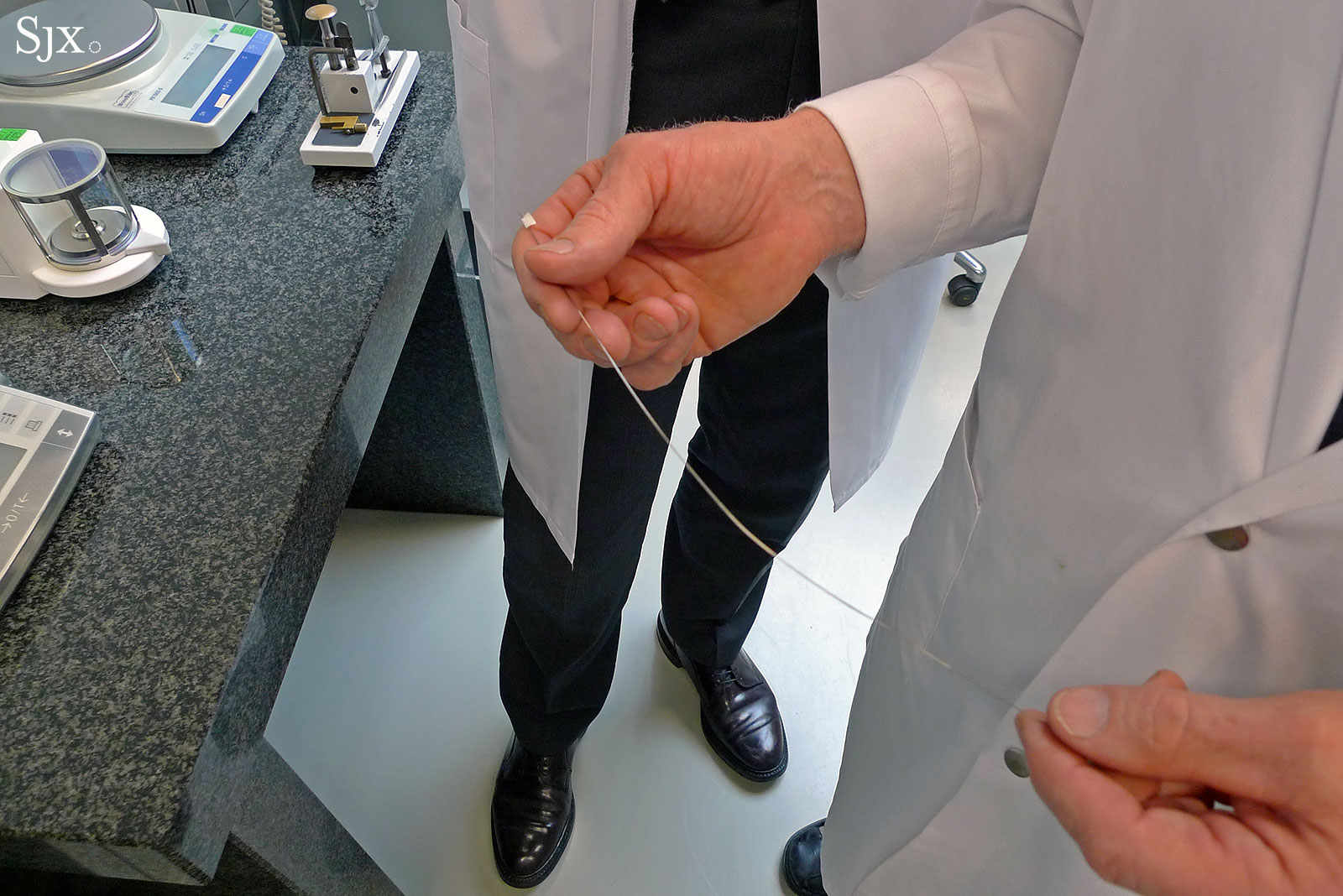
The raw wire that is transformed into a hairsprings
Improved finishing
When I unboxed the Saxonia Thin, I immediately noticed that the movement finishing was better than I expected. In fact, I’d be hard-pressed to name another movement available for less than $25,000 that offers this level of movement finishing. The Breguet cal. 777Q and Vacheron Constantin cal. 4400 deserve honourable mentions, but lack some of the exuberant flourishes, such as the black-polished steelwork, and consistency of execution that I appreciate in the L093.1.
The first thing I noticed is that Lange has started finishing the recess for the click and click spring using perlage. In older examples that I’ve seen in person and viewed online, this area was finished with a matte finish. This was the case not only for the L093.1, but also the L095.2 used in the 1815 Up/Down.
However, many of Lange’s more expensive watches, such as the Richard Lange Pour le Mérite and the Zeitwerk Date, feature perlage in this area and I was pleasantly surprised to see this flourish extended to the L093.1 in the Saxonia Thin. This is another example of Lange’s commitment to finishing all of their watches to the same high standard.
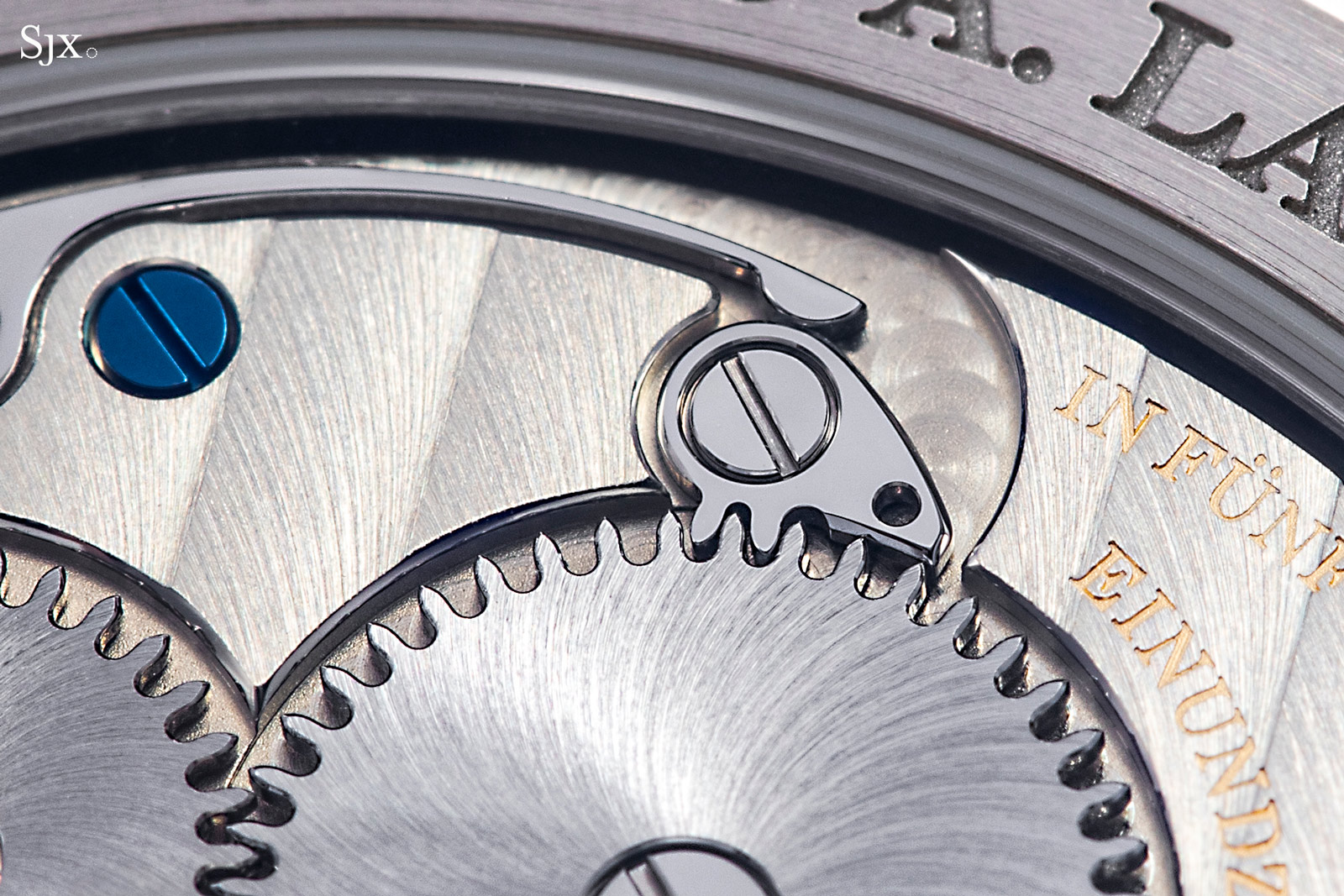
Inside the Saxonia Thin – the recess for the black-polished steel click and click spring now features a perlage finish.
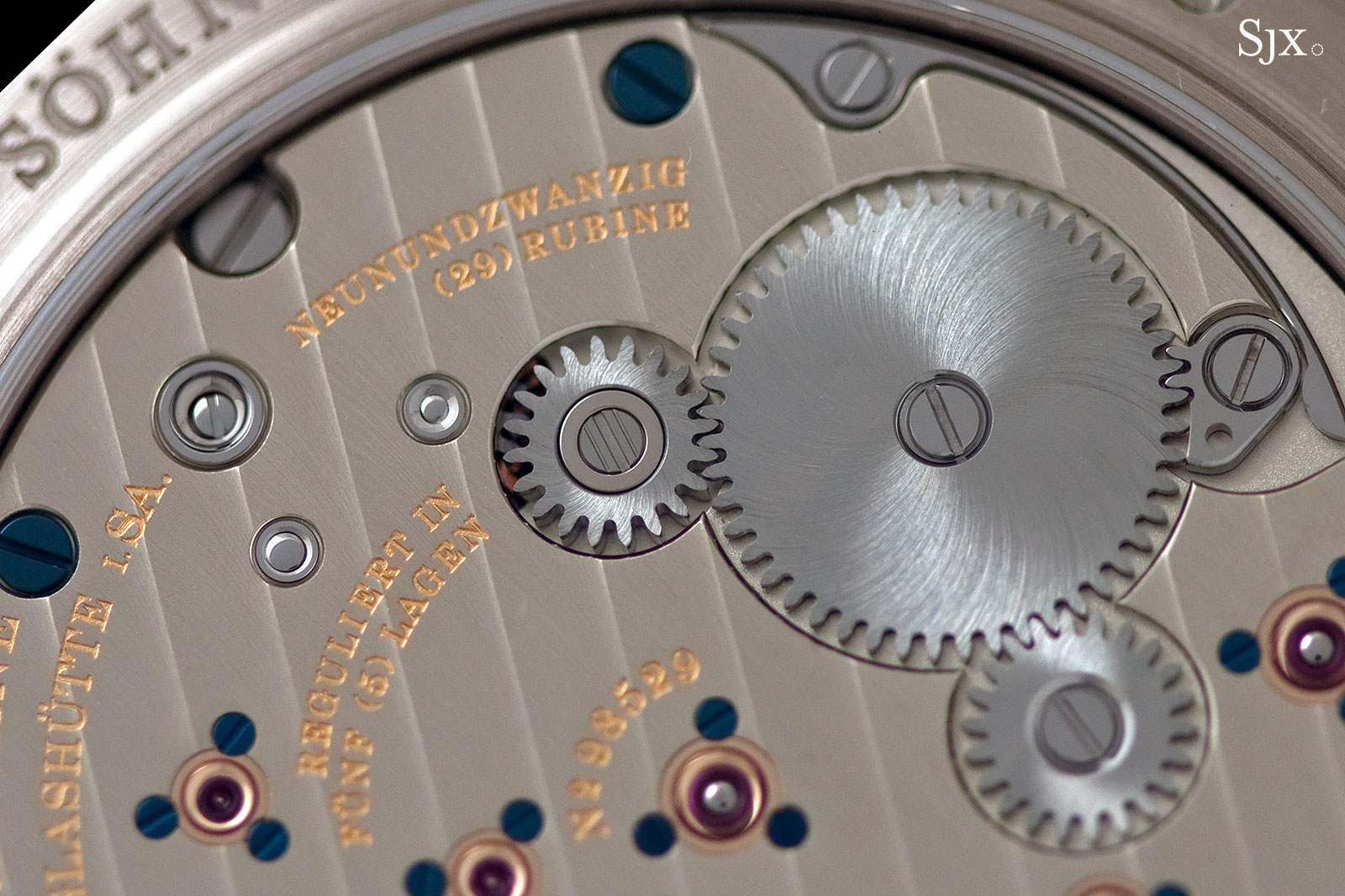
For the purpose of comparison, this image from 2013 shows the L051.2 used in the 1815 Up/Down. Note the matte finished surface treatment in the recess for the click and click spring.
I was also surprised by the lustre of the polished teeth on the crown and ratchet wheels, which gleam brilliantly when they catch the light. I did not expect the bevels on the teeth of the ratchet wheel to be so wide; this is another area where finishing has improved.
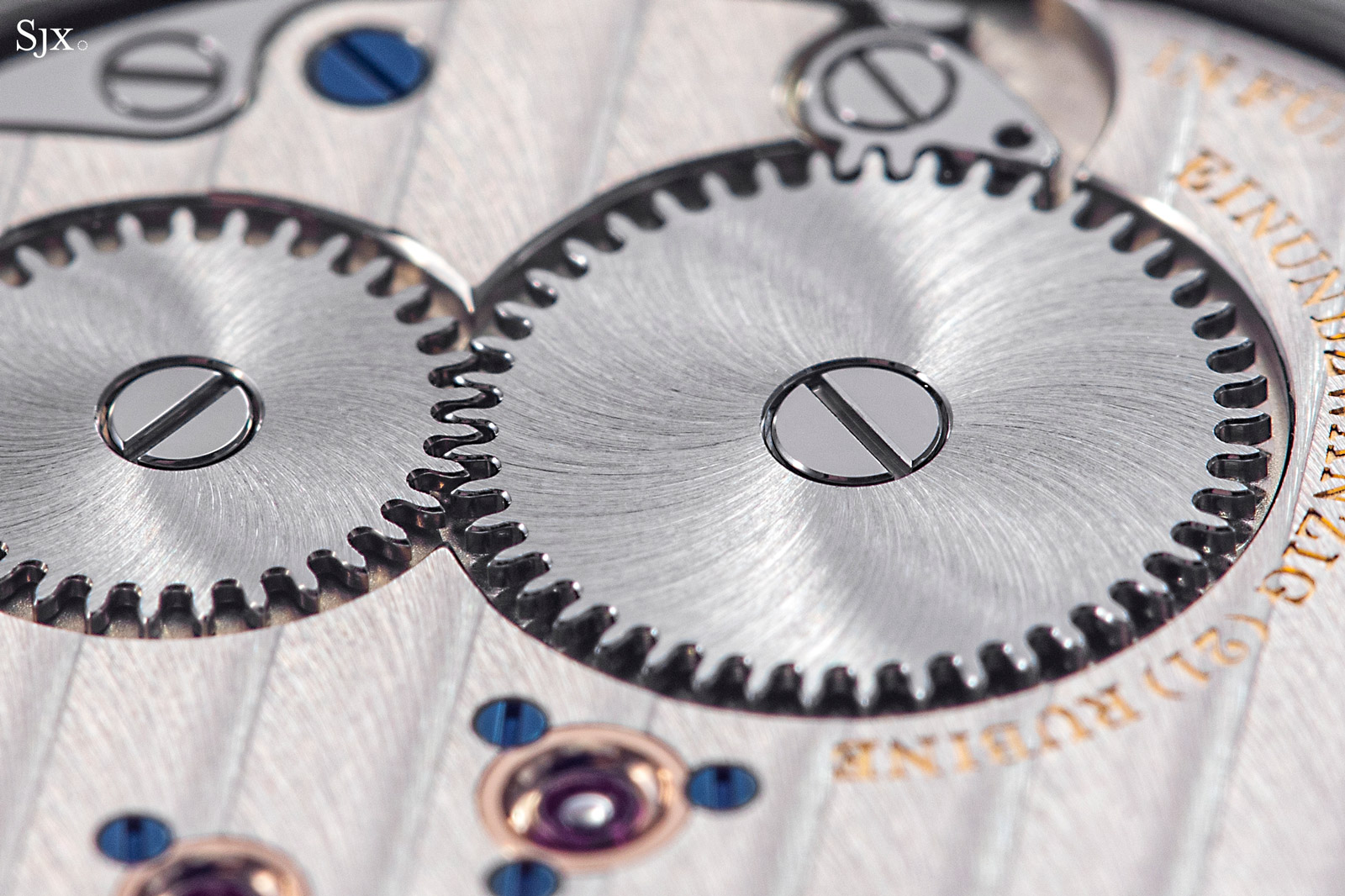
The Lange L093.1. Each tooth of the crown wheel (left) and ratchet wheel (right) is individually polished.
An artisan’s touch
One of the characteristic traits of every Lange movement is the freehand-engraved balance cock. Because they are engraved without stencils or templates, each engraving is unique.
Not only that, but each engraver has their own distinctive style and can recognize their own work, even years later. In my watch specifically, the balance cock was engraved by the talented Stefanie Rohn.
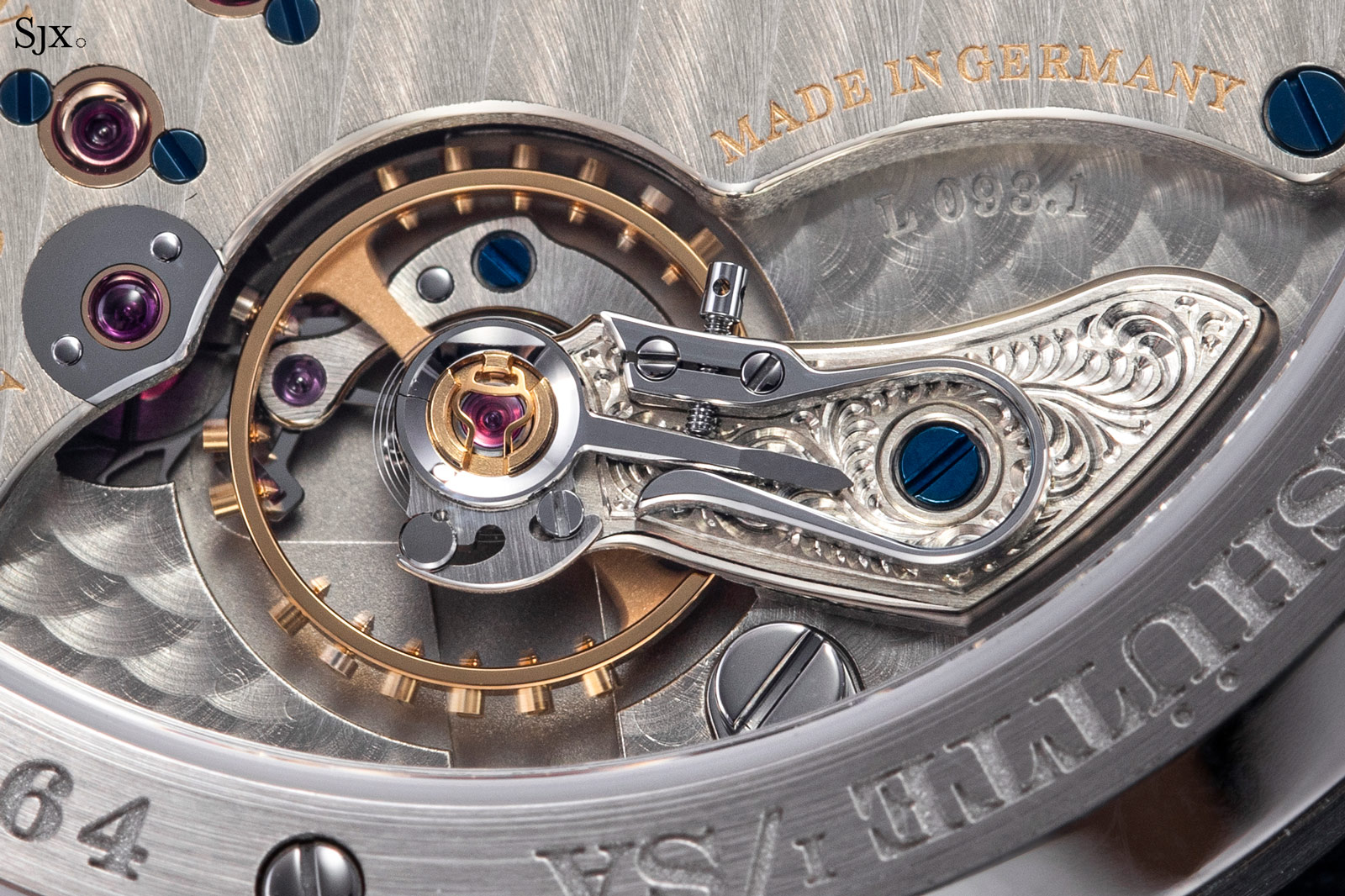
If you’re looking for the stamp of an artisan’s touch, you need look no further than the balance cock of a Lange watch.
Room for improvement (no pun intended)
No watch is perfect, and even the Saxonia Thin could be improved. Specifically, I’d like to see more efficient use of the space within the movement. As we’ve explored previously in our analysis of movement designs, efficient use of the space inside the movement can pay dividends in timekeeping performance.
As you can see in the image below, the barrel does not extend to the edge of the base plate, and there’s a surprisingly large amount of unused space that could be repurposed to accommodate a larger balance. In fairness, the ‘unused’ space is left thicker, which probably contributes to the robustness of what is still a very thin movement.
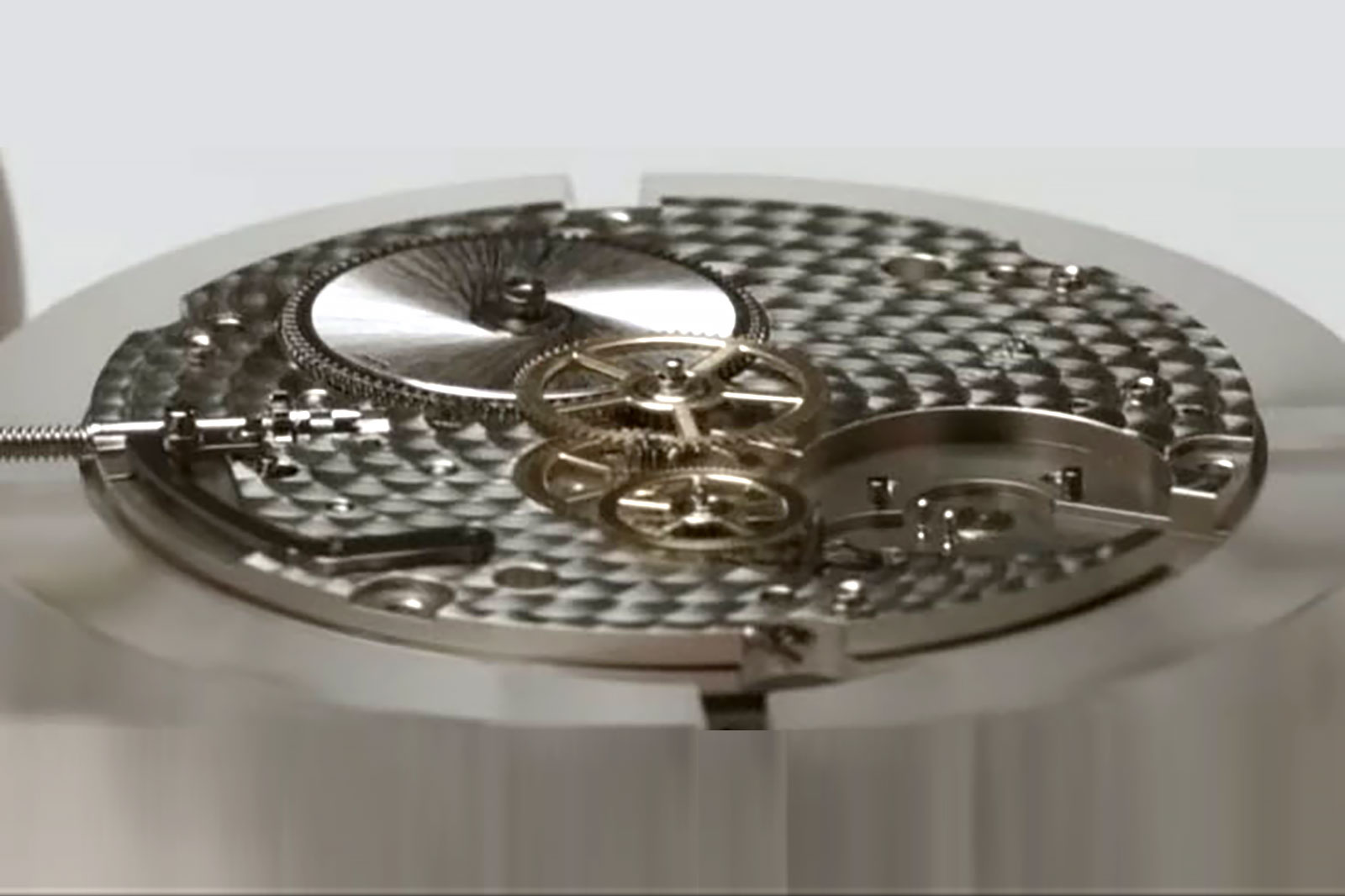
The baseplate of the L093.1. Note the unused space that could be repurposed to accommodate a larger balance and spring barrel. On the bright side, it’s worth noting that even the unseen parts of the movement, like the polished sinks on the hubs of the train wheels, receive a great deal of hand finishing. Photo – A. Lange & Söhne.
I’m also somewhat conflicted about the use of a screwed balance, as opposed to the preferable solution of masselottes (like the L094.1) or recessed timing screws (like the L155.1) for rate adjustment.
The balance in the L093.1 is, as Chamberlain would say, “very much bescrewed”, featuring four gold timing screws and 14 decorative poising screws. I say decorative, because modern balance wheels are poised automatically using a laser.
This is not ideal because a screwed balance is less aerodynamic than a balance with a smooth rim. This may seem trivial, but aerodynamic drag may reduce balance amplitude by as much as 25 degrees, according to technically-minded watch reviewer Walt Odets.
On the other hand, a screwed balance is more traditional and, to my eye, more beautiful. In this context, in a movement that’s clearly intended to be a showcase of traditional features, I’m willing to accept the screwed balance, especially since it’s free-sprung.
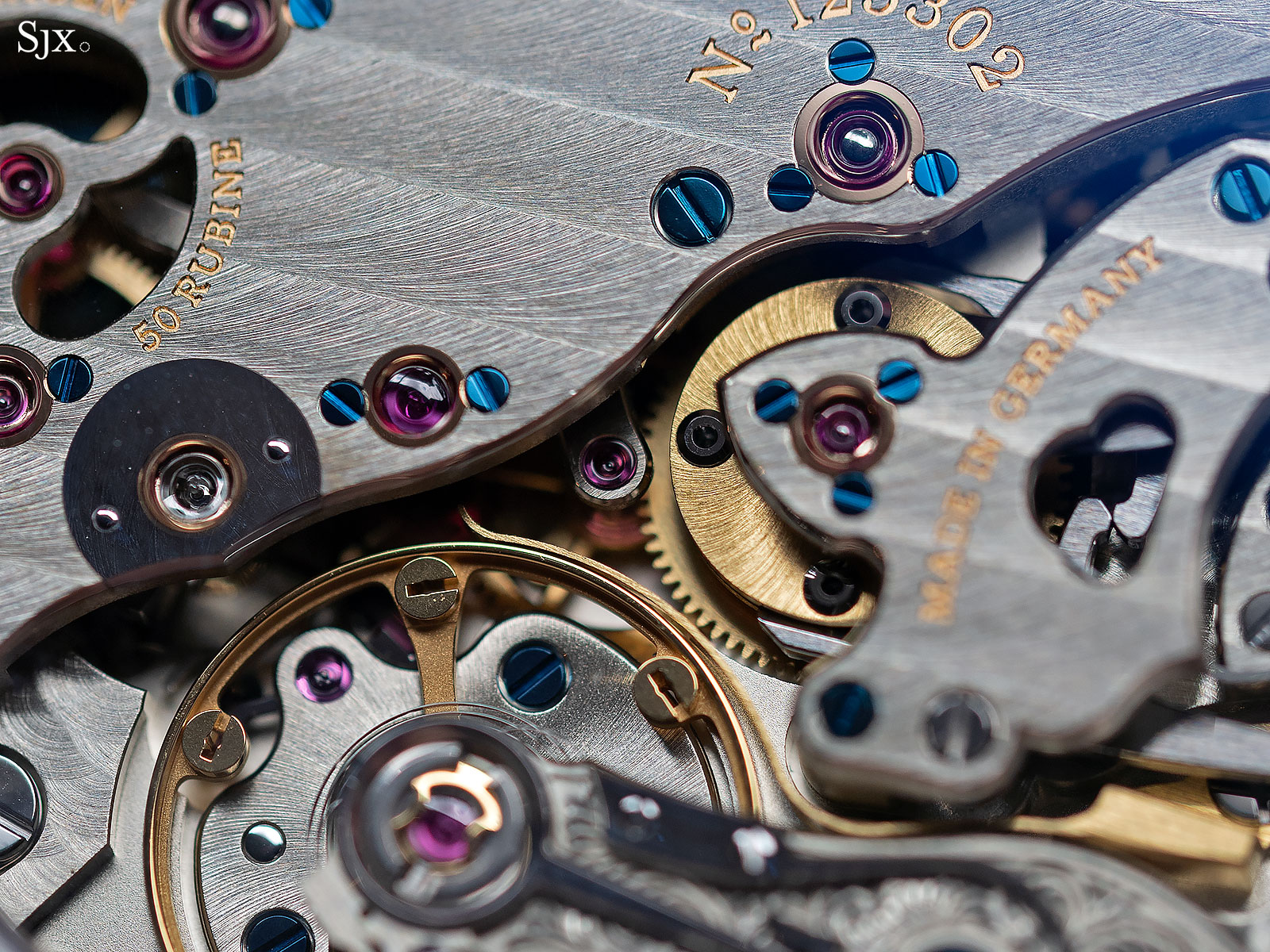
The masselotte weights for timing adjustment in the Lange L094.1.
Timekeeping performance
Theoretical critiques aside, real-world timekeeping performance has been outstanding.
Though the watch lacks a seconds hand, it’s possible to take accurate readings when the minute hand is perfectly aligned over one of the dial markers, since it’s only a couple seconds between when the glimmer of the dial marker disappears on one side of the minute hand and when it catches the light again on the other. It’s not an exact science, but measured over a long period this method will give a good indication of the average daily rate.
Using this method, I carefully tracked the timekeeping over a 31-day observation period, during which the watch gained a total of 39 seconds. In other words, the average daily rate was +1.25 seconds a day.
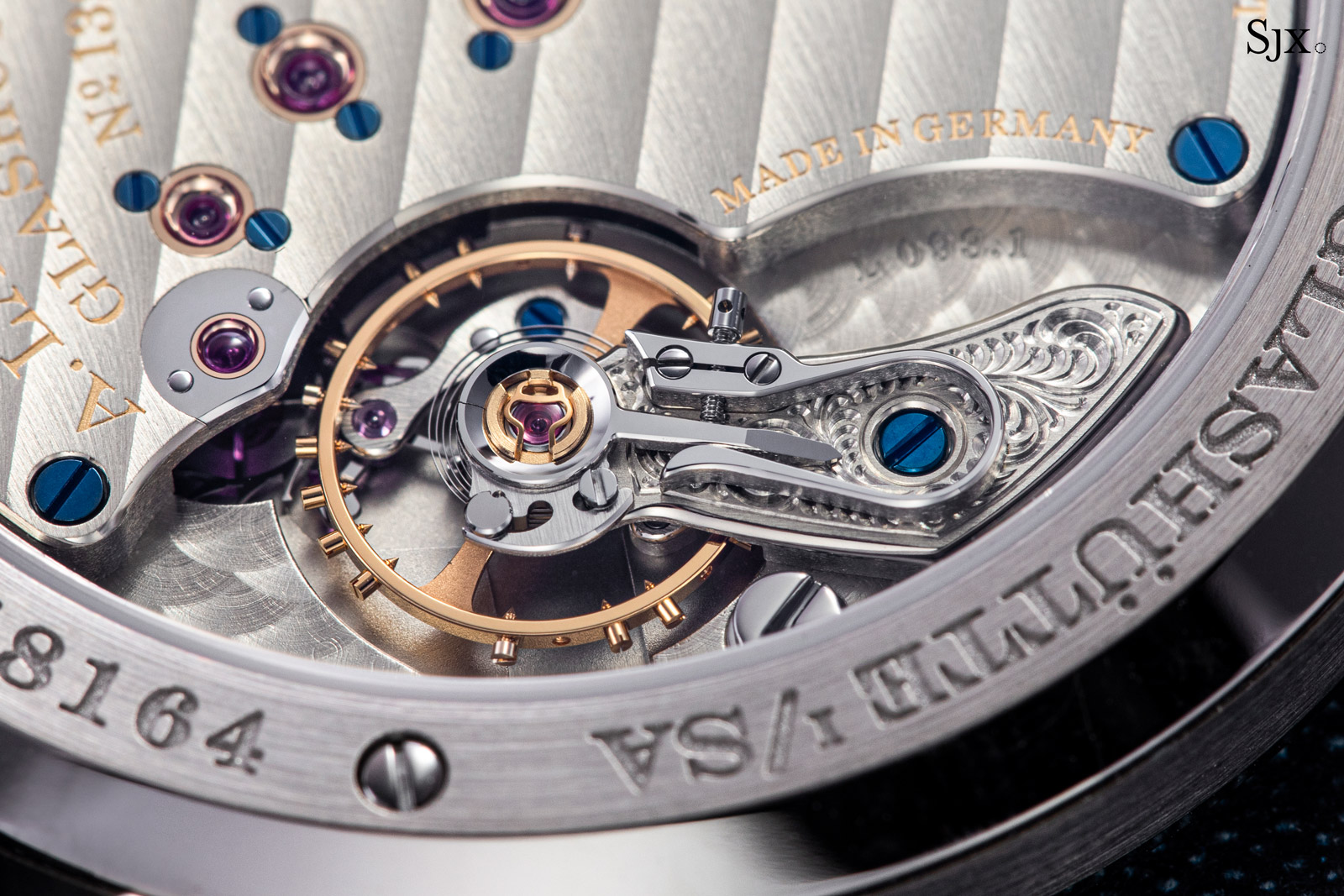
I can’t speculate as to how the movement would fare in a formal chronometry test that measures the rate in different positions, but this is exceptional – perhaps even “superlative” – real-world performance for an ultra-thin movement. The fact that a watch without a running seconds hand was adjusted to this degree speaks volumes about the watchmaking ethos at Lange.
On the wrist
The Saxonia Thin is exceedingly comfortable to wear due its elegant proportions and 43 mm lug-to-lug length. It’s lightweight (57 g including the pin buckle) on account of its small size but heavier than it looks due to the weight of the gold case and silver dial, a trait that gives it a very satisfying feel in the hand and on the wrist.
Specifically, the Saxonia Thin weighs almost 9g/cm3, more than twice the weight per unit of volume of my Sinn 6060 GMT in steel, which tips the scales at just over 4g/cm3.
Visually, I feel like the watch wears larger than its 37 mm diameter would suggest. This is due to the minimalistic dial and relatively thin bezel. Personally, I’d have guessed it was 38 mm. Either way, it’s a good fit for my 7” wrist.
The slender height of the watch is one of its best qualities. At 5.9 mm thick, the Saxonia Thin is the thinnest watch Lange has produced, and also the thinnest watch I’ve owned.
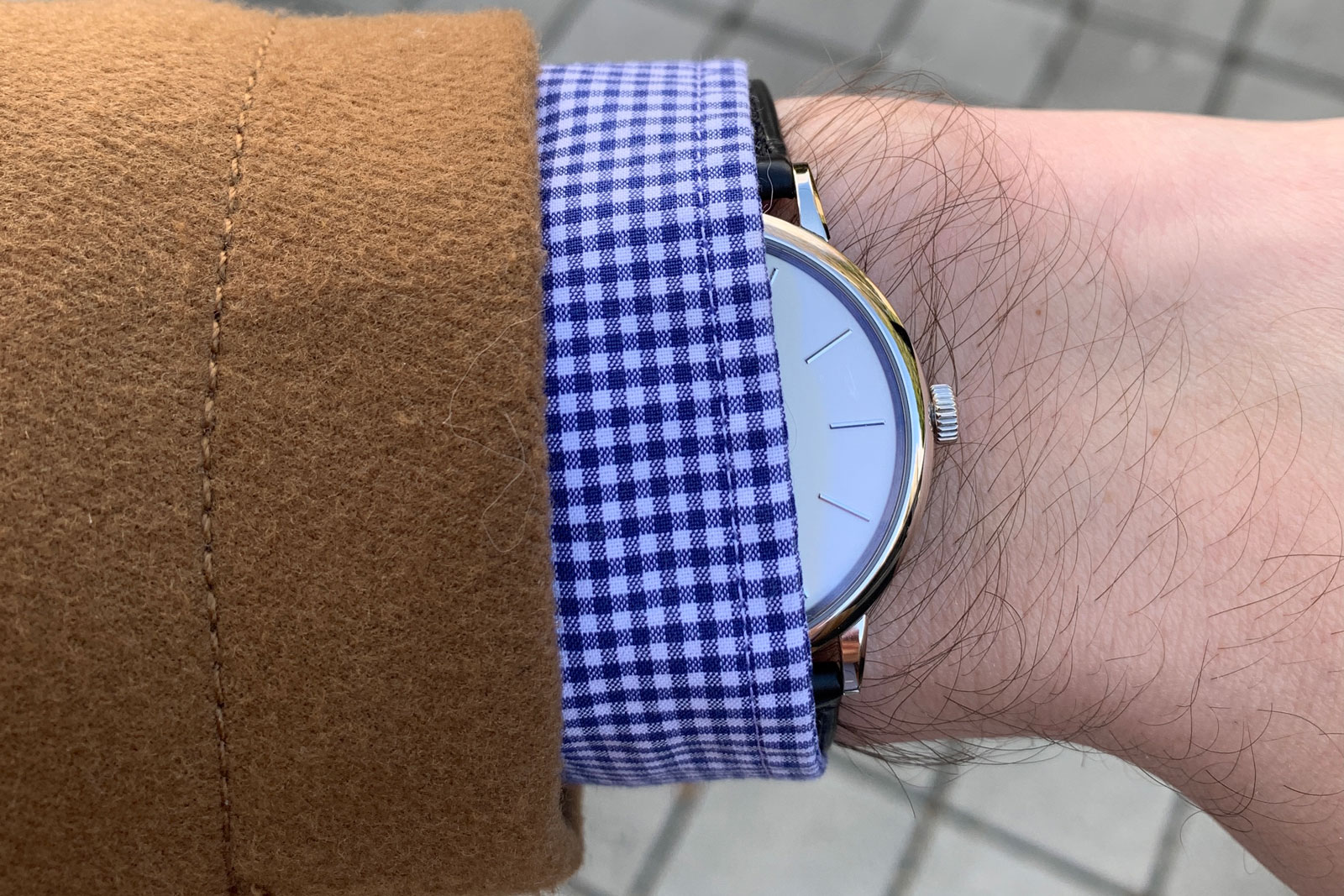
Under a cuff. Photo – the author
Value
I don’t think it’s worth speculating on the future value of the Saxonia Thin. Dress watches, as a category, are not “hot” on the secondary market, and I bought this watch because I wanted to wear it, not because I wanted to flip it.
That said, the spread between the retail price and the secondary market price is very small, which suggests the watch will likely retain the bulk of its value.
In terms of relative pricing, I think Lange priced the watch too low when it launched in 2016, and even after the 12% price increase in March 2021 it’s still a very compelling value compared to similar watches in the Lange collection (like the 1815 Thin Honeygold “Homage to F.A. Lange”) and those from rivals like Patek Philippe and Vacheron Constantin.
Summary
The process of buying a watch is very personal and often demands both introspection and research. I bought the Saxonia Thin after a long period of deliberation and a careful study of my options.
I chose this model because I liked the design and felt like it offered a lot of watch for the money in terms of both craftsmanship and technical content. After 180 days of ownership, I feel even more certain about the value.
While I based my original value assessment primarily on the qualities of the movement, the subtle nuances of the case and dial have revealed themselves over time. Add to that technical features like the free-sprung balance and 72-hour power reserve, and it’s a very complete package.
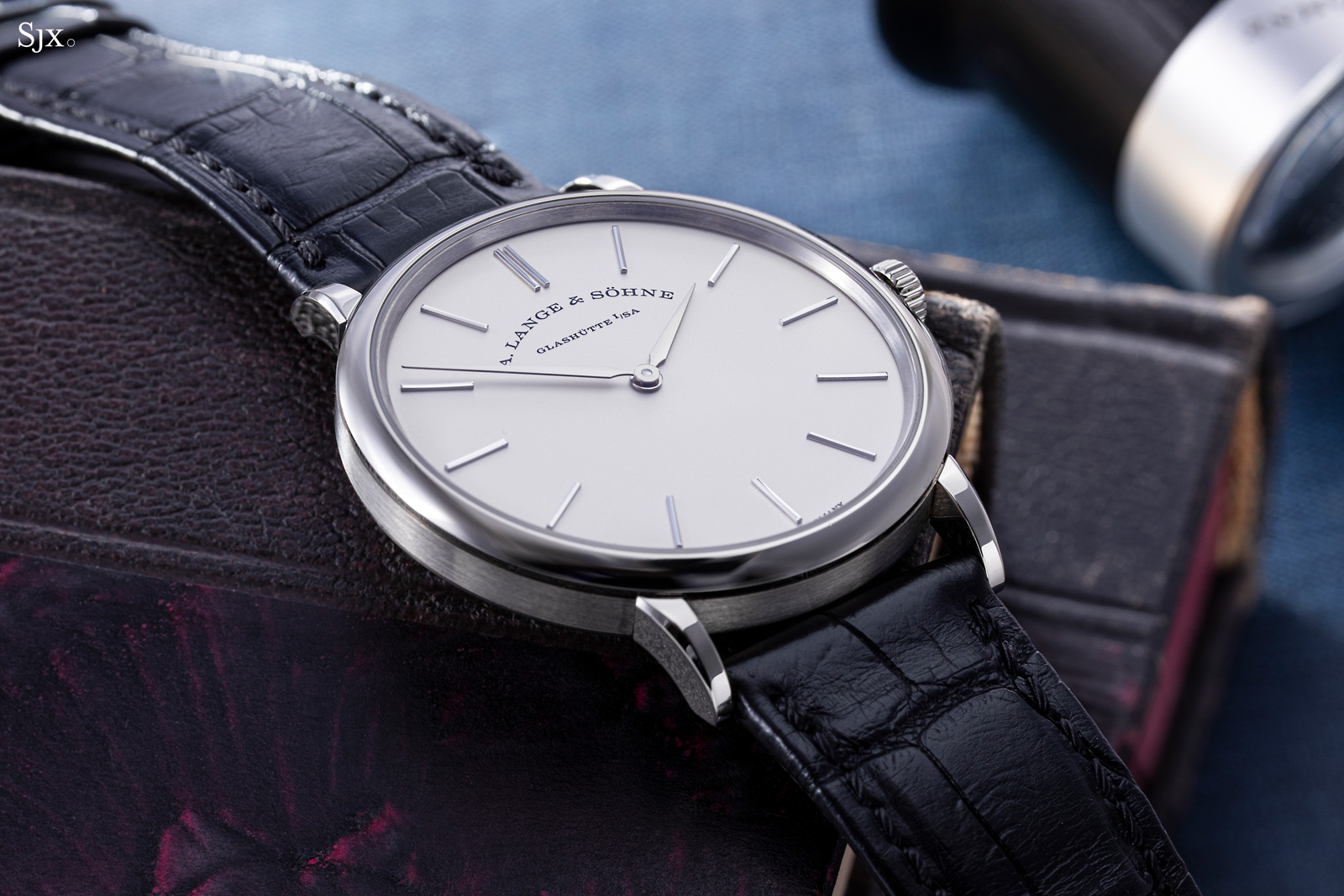
But it’s not a watch for everyone. Its compact dimensions and restrained design help it fly under the radar – and under the shirt cuff – but limit its distinctiveness and mass appeal. I’ll be the first to admit it probably won’t generate a lot of attention on Instagram or at collector events. But this subtlety is something I appreciate about the watch.
As for Lange’s reputation for finishing its entry-level pieces to the same standard as its pricier flagship models, I can confirm this reputation stands up to hours of careful scrutiny. In fact, the finishing of the L093.1 seems to have actually improved in recent years with the addition of perlage in the hard-to-reach recesses of the click and click spring, and improved finishing of the teeth on the ratchet and crown wheels.
In conclusion, the Saxonia Thin is everything I thought it would be and more, and I’m confident it will be an important part of my collection for years to come.
Key facts and price
A. Lange & Söhne Saxonia Thin
Ref. 201.027
Diameter: 37 mm
Height: 5.9 mm
Material: 18k white gold
Crystal: Sapphire
Water resistance: 30 m
Movement: L093.1
Functions: Hours, and minutes
Frequency: 21,600 beats per hour (3 Hz)
Winding: Hand-wind
Power reserve: 72 hours
Strap: Crocodile with pin buckle, folding clasp optional
Availability: Now at boutiques and retailers
Price: US$17,800
For more, visit alange-soehne.com.
Back to top.